Physical Address
304 North Cardinal St.
Dorchester Center, MA 02124
Several structural and functional units have been proposed in the microanatomy of the liver. Of these, the most relevant for the diagnostic histopathologist are the liver lobule and the liver acinus. For several years the liver acinus was the preferred concept in textbooks of pathology and hepatology, as it appeared to better explain the “bridging” type of lesions connecting afferent and efferent vascular landmarks, that is, portal–central bridging necrosis and fibrosis. The simple liver acinus corresponds to the small area of parenchyma vascularized by a single terminal branch of the portal vein (portal venule) and hepatic artery, and drained by the neighboring terminal hepatic venules. In spite of its popularity in recent years, the liver acinus did not withstand the scrutiny of further detailed angioarchitectural, morphologic, and histochemical investigations, and virtually all later studies support the lobular concept of liver architecture, albeit with several types of subunits.
The classical hexagonal liver lobule is centered on a terminal twig of the hepatic vein (centrilobular or central vein), and surrounded by (on average) six portal tracts. The portal vein ramifications in the portal tracts give off a series of branches in the plane between adjacent portal tracts; these in turn give rise to sinusoids that drain the blood toward the center of the lobule. The lobular equivalents of the acinar zones 1, 2, and 3 are the periportal zone, midzonal or midlobular zone, and centrilobular area.
The liver parenchymal cell or hepatocyte is a polygonal cell with a characteristically central, single nucleus. Hepatocytes are arranged in plates one to two cells thick with a sinusoid on either side, thus exposing each hepatocyte to portal blood on two surfaces. Within the cell plate each hepatocyte adjoins adjacent parenchymal cells at its intercellular surface. This intercellular domain of the cell membrane forms a groove (hemicanaliculus) as a girdle around the cell. The hemicanaliculi of two adjacent hepatocytes form the intercellular bile canaliculus, which is separated from the rest of the intercellular space and the blood compartment by tight junctions.
The virtual cleft between the sinusoidal lining cells and the sinusoidal domain of the hepatocyte surface is the space of Disse. It is not typically visible in biopsy material but appears dilated in autopsy specimens. The hepatic sinusoids are lined by different cell types. The sinusoidal endothelial cells are of the fenestrated type. Kupffer cells, which are resident members of the mononuclear phagocyte system that undergo enlargement and proliferation in response to a wide variety of stimuli, bulge out on the luminal side of the sinusoids. Hepatic stellate cells (previously known as Ito cells, fat-storing cells or lipocytes) are contractile perisinusoidal “pericytes” located in the space of Disse. They store vitamin A in their cytoplasmic lipid droplets and are able to switch their phenotype to myofibroblast-like cells under appropriate stimulation. Stellate cells are matrix producers in both normal liver and in pathologic intralobular fibrosis. Hepatic stellate cells are only identified with difficulty in routinely stained preparations; immunostaining for synaptophysin marks both resting and activated cells, and immunostaining for alpha-smooth muscle actin reveals activated stellate cells. Located on the inside of sinusoidal endothelial cells are some scattered “pit cells,” which are resident intrahepatic lymphocytes, primarily natural killer phenotype.
The portal tracts at the lobular periphery are composed of connective tissue, ensheathing branches of the hepatic artery, portal vein, bile duct, and lymphatics. The caliber of portal tracts and their composing structures decreases from the hilum of the liver toward its periphery; this explains why surgical liver biopsies and autopsy specimens usually contain larger portal areas than needle biopsy specimens. The microarchitectural variability is also greater in the peripheral liver. On average, one may expect two interlobular bile ducts, two hepatic arteries, and one portal vein per portal tract, but in peripheral liver, portal dyads (containing only two of the three artery, vein, or bile duct profiles) are almost as common as portal triads.
Interlobular bile ducts, usually located in the center of the portal tract, are connected with the lobular canaliculi by ductules (or cholangioles) and canals of Hering, the latter being short stretches lined by both hepatocytes and cholangiocytes. These finer structures are hardly visible on hematoxylin–eosin (H&E) staining but clearly revealed by cytokeratin immunostains.
Liver cell plates and sinusoids have a more regular radial arrangement in the center of the lobule, whereas the periportal zone is characterized by a less regular, anastomosing network pattern of these structures.
Hepatocytes are polygonal in shape, with clearly outlined cell membranes in H&E preparations. The cytoplasm is granular and eosinophilic, with basophilic aggregates of rough endoplasmic reticulum in a perinuclear distribution. The nucleus is centrally placed and carries one or more easily identifiable nucleoli. Mitotic figures are very rare. Hepatocytes are rich in glycogen, with diurnal and diet-related variations in amount and distribution. Glycogen accumulation in nuclei occurs as clear vacuoles, predominantly in periportal hepatocytes. This is common in childhood and may be conspicuous in some adult diseases (e.g., diabetes and Wilson disease) but is not by itself of diagnostic significance. Lipofuscin occurs as fine, light brown, periodic acid–Schiff (PAS)-positive and acid-fast granules in the pericanalicular region of centrilobular hepatocytes ( Fig. 19.1 ); it should not be mistaken for bile. Stainable iron is absent or demonstrable in only scant amounts in the adult liver. An occasional hepatocyte in normal liver may contain fat.
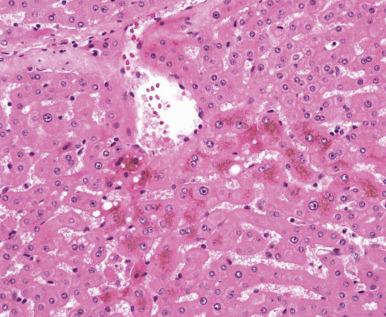
There is some variation in hepatic microscopic appearance with age. In neonates, extramedullary hematopoiesis may persist during the first weeks of life. With increasing age, there is more variation in nuclear size (anisokaryosis), somewhat more pronounced centrilobular lipofuscinosis (“wear and tear pigment”), some atrophy of centrilobular hepatocytes and correspondingly broader appearance of perivenular sinusoids, occasional hyalinization of the wall of hepatic artery branches, and thickening of the liver capsule with some fibrous extensions reaching for 1–2 mm into the underlying parenchyma.
Physiologic postnatal liver development comprises three structural components: enlargement of the hepatocytes and expansion and proliferation of the liver lobules. Enlargement of the lobules is exclusively responsible for the regenerative liver growth following partial hepatectomy; the number of hepatic lobules does not change during this latter reaction, but they gain a more complex, irregular structure.
Light microscopic examination of liver tissue remains an essential part of the diagnostic procedure and of the follow-up of the majority of liver diseases. Biopsies obtained during surgical procedures may show “surgical hepatitis,” appearing as a neutrophilic infiltrate that may be accompanied by coagulative necrosis of single or small groups of hepatocytes ( Fig. 19.2 ). The lesion is usually centrilobular, but its extent depends on the duration of the operation and the degree of manipulation of the liver. For this reason, biopsies obtained during surgery should be performed immediately on entering the peritoneal cavity. It is also important to note that the subcapsular area is not representative of the entire organ; marked subcapsular fibrosis may coexist with minimal changes deeper in the liver, and contraction of the elastic fibers in the capsule after wedge biopsy may mimic cirrhosis. Therefore, the surgeon should perform not only an incisional biopsy but also a deeper needle biopsy.
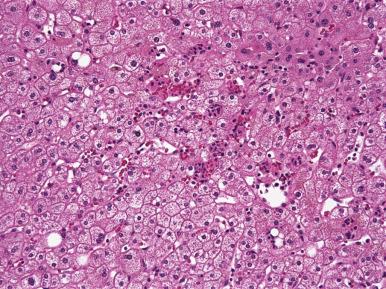
The indications for and diagnostic usefulness of liver biopsy change over time. The availability of serologic tests for the etiologic diagnosis of acute viral hepatitis has reduced the need for liver biopsy in this condition, and transient elastography (FibroScan) is replacing biopsy for extent of fibrosis in chronic viral hepatitis in some settings. The refinement of liver imaging techniques and of endoscopic retrograde cholangiopancreatography (ERCP) has also rendered the use of liver biopsy for the diagnosis of large bile duct obstruction largely obsolete. However, liver histopathology remains a mainstay in the diagnostic work-up of most liver diseases, and several studies over the years have emphasized its diagnostic usefulness and importance to therapy. With the advent of liver transplantation, liver biopsy remains the gold standard for the diagnosis of cellular rejection and for diagnosis of infection, vascular complications, and recurrence of disease in the transplant setting. In an appreciable number of cases, the pathologist may discover the presence of an unsuspected diagnosis in addition to the clinically presumed diagnosis, for example, α1-antitrypsin (α1-AT) deficiency or non-alcoholic fatty liver disease (NAFLD) in a patient with known chronic viral hepatitis B or C. In a recent Canadian study, such findings amounted to 20% of hepatitis biopsies.
As in all of diagnostic histopathology, the H&E stain is the mainstay in liver pathology. Special stains are useful for visualizing inapparent or easily overlooked features, but the number and type performed routinely is a matter of personal preference, and varies from one laboratory to the next. The strict minimum is an H&E and a connective tissue stain. Many pathologists also routinely employ an iron stain for assessing iron deposition; PAS–diastase stain for ceroid macrophages, α1-AT inclusions, fungi, and thickened basement membranes of interlobular bile ducts; the rhodanine stain for copper (in Wilson disease, chronic cholestasis, and copper toxicosis); and a reticulin stain for examining the reticulin framework and revealing parenchymal collapse. Immunohistochemical staining for “bile duct type keratins” (keratins 7 and 19) may be extremely useful in cholestatic liver diseases, for recognizing early stages of cholate stasis, cholestatic liver cell rosettes, ductular reaction, and ductopenia. Over the years, the accuracy and diagnostic yield of liver histopathology have been steadily increasing through expanding availability of immunohistochemistry.
The diagnostic accuracy of liver histopathology depends on numerous factors, which are not always optimal in every instance and which hardly lend themselves to quantitative evaluation. Several factors relate to the biopsy specimen. Size is important, although not in an absolute way; because the average needle biopsy represents 100 thousandth to 150 thousandth (0.00001–0.000006666) of the liver organ, sampling variability and error is an obvious possibility. A reliable diagnosis of a disease with unequal involvement of portal tracts (such as chronic hepatitis or primary biliary cirrhosis [PBC]) often requires a larger sample than a condition with diffuse involvement (such as classic acute hepatitis). The minimum size requirements for a diagnostic biopsy and the minimum number of portal tracts remain controversial. One study evaluating grading and staging in chronic hepatitis indicated that smaller specimens result in both undergrading and understaging disease, and that a minimum biopsy sample should be 15 mm or a core comprising at least 11 complete portal tracts. Another study suggested that a length of at least 25 mm is necessary to evaluate fibrosis accurately with a semiquantitative score. In NAFLD, a significant relationship was also found between diagnostic yield and sample length. On the other hand, there are studies that show that the level of experience in evaluating liver biopsies is more important than the length of the core. Regardless, the pathologist should carefully examine even inadequately sized specimens in order to ensure maximum yield of information from an invasive procedure. The diagnostic accuracy of focal lesions (e.g., granulomas, cytomegalovirus [CMV] inclusions) is also improved by examining multiple sections. Other factors affecting diagnostic yield include experience of the pathologist, availability of clinical information, and knowledge of clinical implications. Even under optimal circumstances, however, an adequate biopsy may not provide a complete diagnosis, or may even fail to give helpful information.
Although a reliable final diagnosis definitely requires knowledge of laboratory information and the clinical background of the patient, it is equally true that objectivity in analysis and conclusion is best served by examination of the slides without any other clinical or laboratory information. Several reviews on how to systematically examine a liver biopsy are available, including a position paper from the American Association for the Study of Liver Diseases (AASLD) addressing pathologic considerations of specimen size and quality, tissue allocation, tissue processing, specimen interpretation, and sampling error.
Viral hepatitis, or liver inflammation due to viral infection, may be caused by specific hepatotropic viruses (the “hepatitis viruses”) and by several other viruses that primarily cause generalized infection that may involve the liver (e.g., CMV, Epstein–Barr virus [EBV]).
Historically, when adequate diagnostic tests for hepatitis A virus (HAV) and hepatitis B virus (HBV) became available in transfusion centers for screening of donor blood, it became evident that a fraction of post-transfusion viral hepatitis was not due to HAV or HBV, and thus designated by the term non-A, non-B hepatitis. After more than a decade of intensive research, hepatitis C virus (HCV) was discovered and found to be responsible for the majority of non-A, non-B hepatitis.
Now there are at least five distinct hepatotropic viruses, belonging to entirely different families ( Table 19.1 ). They have very little in common except that they affect the liver as a target organ, and some degree of shared epidemiology. All have a worldwide distribution. Two of these viruses (HAV and HEV) are spread principally by the fecal–oral route, and three (HBV, HCV, HDV) are spread mainly by exposure to blood, although HBV and HCV may also be spread by unprotected sex. HEV causes a self-limited and often anicteric hepatitis in the West, where it is likely underdiagnosed. It is a major health problem in developing countries, however, causing high morbidity and often fulminant hepatitis in pregnant women in certain geographic areas (e.g., India).
| VIRUS | TYPE AND FAMILY | INFECTION ROUTE | DISEASE |
|---|---|---|---|
| Hepatitis A (HAV) | Single-stranded RNA virus Picornaviridae family | Fecal–oral, oral | Acute |
| Hepatitis B (HBV) | Partially double-stranded DNA virus Hepadnaviridae family | Parenteral, sexual, perinatal | Acute, chronic |
| Hepatitis C (HCV) | RNA virus Flaviviridae family |
Parenteral, sexual, perinatal | Acute, chronic |
| Hepatitis D (HDV, Delta agent) | Defective RNA virus | Parenteral, sexual Requires coinfection with or superinfection of HBV |
Acute, chronic |
| Hepatitis E (HEV) | Single-stranded, nonenveloped RNA virus Caliciviridae family |
Vertical, oral, parenteral | Acute |
More recently identified hepatitis viruses (non-A-E viruses) include hepatitis G virus (HGV or GBV-C, family Flaviviridae) ; Torque teno virus (TTV), a DNA virus of the family Circoviridae ; and SEN virus, a transfusion-transmitted DNA virus. The clinical significance of HGV, particularly in the context of patients with chronic liver disease due to HBV or HCV, remains controversial. There is some evidence that although coinfection of HGV in patients with chronic hepatitis B or C does not affect disease severity, it may accelerate the progression of chronic liver disease and the development of hepatocellular carcinoma. TTV and SEN viruses appear to be extraordinarily diverse and to be ubiquitous in >90% of adults worldwide, but no human pathogenicity has been fully established.
The introduction of serologic and molecular tests for hepatitis viruses has decreased the indication for liver biopsy in acute hepatitis. However, biopsy may still be used to confirm a diagnosis, to assess severity and evolution of the disease, and to exclude concomitant disease (e.g., alcoholic liver disease superimposed on viral hepatitis).
The morphologic features of viral hepatitis have been extensively described. The histologic picture of acute hepatitis due to different hepatitis viruses may be sufficiently similar to cause problems in differentiation. The general changes of hepatitis are described later, followed by some characteristics specific to individual viruses.
Typical acute viral hepatitis is a panlobular disease, although the changes may predominate in the centrilobular region in HBV and HCV, and in the periportal zone in HAV. Hepatocellular alterations are variable and include a predominantly mononuclear lobular inflammation and spotty hepatocyte necrosis. Some parenchymal cells show swelling, with increased cell volume and pale-staining, granular cytoplasm (so-called hydropic change). The heterogeneous appearance of the parenchymal cells (due to hepatocyte swelling and necrosis), together with cell dropout and regeneration of surviving hepatocytes, leads to a loss of the normal regular liver cell plate pattern; this “lobular disarray” is also a very diagnostically helpful feature ( Fig. 19.3 ). Reactive hepatocellular changes may be prominent, including hepatocytes undergoing mitosis. Syncytial, multinucleated giant hepatocytes, which are typical of neonatal hepatitis, may sometimes be found in adults as well, but this does not indicate a specific etiology.
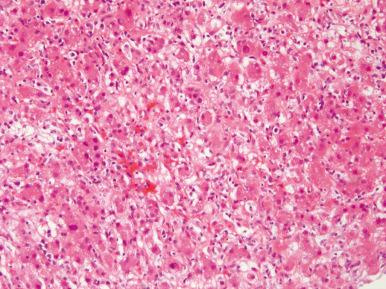
There is a predominance of mononuclear and lymphocytic cell types. The majority of lymphocytes are activated memory T cells. Also, plasma cells may be found in the early stage. Small clusters of lymphocytes, whether or not in close proximity to apoptotic bodies, represent foci of cytotoxic lymphocyte–mediated target cell attack and represent the lesion indicated by the terms “focal inflammation,” “focal necrosis,” and “spotty necrosis.”
Kupffer cells enlarge and become more prominent; they phagocytose cell debris from dying hepatocytes, which results in the intracellular accumulation of clumps of golden brown, lipid-rich “ceroid” pigment, which is best revealed in PAS–diastase stains. In the earlier stages, these “ceroid macrophages” are small and scattered as single cells; later on, they may be larger and form clusters that predominate in centrilobular and midzonal areas. In still later stages, they are found migrated into the portal connective tissue. Ceroid macrophages in acute viral hepatitis may stain for iron in some cases. Some degree of cholestasis is common as well ( Fig. 19.4 ).
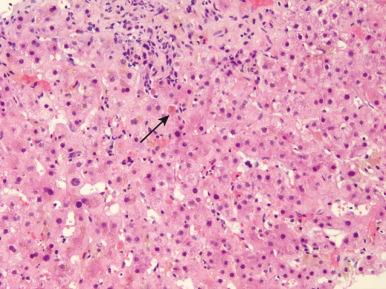
Although the lobular pattern predominates in acute viral hepatitis, the portal tracts often also become involved by a mononuclear cell infiltrate, sometimes admixed with neutrophils, eosinophils, and—especially in the later stages—pigment-laden macrophages. The infiltrate may remain confined within the portal connective tissue, or may spill out into the adjacent periportal parenchyma. An increase in ductular profiles at the portal–parenchymal interface (“ductular reaction”) also occurs in acute hepatitis; this is typically very mild in classic acute lobular hepatitis, and better revealed by keratin 7 immunostains. The extent of ductular reaction increases with the severity of the necrotizing parenchymal lesions. Lymphocytic infiltration between and inside bile duct lining cells, and some degree of bile duct epithelial damage may rarely occur, particularly in HCV, although acute HCV is rarely seen on liver biopsy.
In the later stages of acute self-limited hepatitis, most of the parenchymal and portal changes gradually disappear. Residual changes such as mild portal inflammation, focal lobular inflammation, pigmented macrophages, and reactive hepatocellular changes may persist for several months.
In severe disease, the death of larger groups of hepatocytes with more extensive parenchymal damage leads to “confluent necrosis.” This may initially involve zone 3, but with increasing severity, there may be dropout of parenchyma between portal tracts and central veins (bridging hepatic necrosis ; Fig. 19.5 ). A still higher degree of severity results in necrosis of all acinar zones, resulting in panlobular necrosis. For unexplained reasons, this necrosis usually has an irregular distribution throughout the liver, rendering needle biopsy less reliable for estimating the extent of necrosis in fulminant hepatitis.
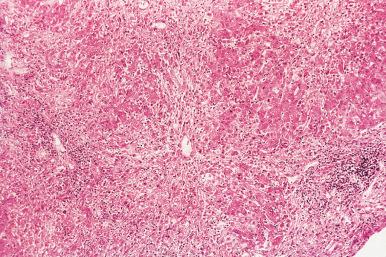
Necrotic bridges change in appearance over time. Freshly necrotizing bridges reveal lobular areas where the parenchyma has disappeared, with no or minimal collapse of the reticulin framework. Resolving necrotizing areas are infiltrated by mononuclear cells and some small ceroid macrophages. Later stages are characterized by collapse of the reticulin fibers, proliferation of mesenchymal cells and collagen deposition, possibly bulging of the regenerating remaining parenchyma, and larger numbers of ceroid macrophages. Older necrotic bridges heal with fibrous scars, resulting in portal–central bridging fibrosis (“post-necrotic cirrhosis”).
Obvious fibrosis is a characteristic of chronic rather than of acute hepatitis, and thus the distinction between post-necrotic cirrhosis and cirrhosis in the context of chronic liver disease is critical. Fibrous bridges in the context of chronic hepatitis can be recognized by the fact that gradual deposition of elastic fibers takes place. Thus, bridging fibrosis in chronic hepatitis stains with an elastin stain, whereas bridges in acute hepatitis do not contain elastin. Severe necrotizing hepatitis is also characterized by a higher degree of periportal ductular reaction. The areas of surviving parenchyma reveal the changes of acute hepatitis described previously for classical lobular hepatitis but usually with more marked spotty necrosis and cholestasis.
Submassive hepatic necrosis . Progressive severe necrotizing hepatitis, which occurs in a minority of patients, may correspond clinically to fulminant hepatitis with acute liver failure and coma. In such patients, lytic confluent necrosis of the parenchyma typically involves the entire liver lobule (panlobular necrosis) and often affects several adjacent lobules (multilobular necrosis). Extensive confluent necrosis is usually distributed in a heterogeneous way throughout the liver organ, thus needle biopsies may not be representative. In surviving patients, multilobular (or submassive) necrosis results in collapse and fibrous scarring of necrotic zones, alternating with nodular regeneration of surviving parenchymal territories.
Ductular reaction is prominent in multilobular necrosis and represents an attempt at regeneration by liver progenitor cells. The epithelial proliferation comprises not only bile ductular cells but also elements with a phenotype intermediate between that of cholangiocytes and hepatocytes—so-called transitional cells. Some of the ductules may contain inspissated bilirubin-stained concrements in cases with severe necrosis or with sepsis ; this lesion should not be mistaken as a sign of biliary obstruction.
Severe necrotizing hepatitis may have causes other than infection by hepatitis viruses, such as autoimmune hepatitis, adverse drug reactions, toxic insults, and Wilson disease. As all or most of the parenchymal cells have disappeared due to necrosis by the time of histologic evaluation, there are few markers pointing to a particular etiology, thus it is often impossible to pinpoint the etiology on histologic grounds alone.
Causative viruses. It is usually not possible to histologically diagnose with certainty the etiology of acute viral hepatitis, since the main histopathologic traits are quite similar; correct diagnosis typically requires serologic and/or molecular testing. Nevertheless, there are suggestive trends and patterns. One has to keep in mind, however, that the histopathologic picture may be confused by coinfection with more than one virus, or by the presence of another form of liver disease (such as fatty liver disease, for example).
Acute hepatitis A may reveal a picture dominated by centrilobular bilirubinostasis with only minimal liver cell damage and inflammation; this may be mistaken for other causes of cholestasis (e.g., drug-induced cholestasis). Particularly in adults, HAV infection may cause cholestatic hepatitis, even occasionally showing bile duct damage. The inflammatory changes often show a periportal predominance, with dense, plasma cell–rich portal infiltrates that may mimic autoimmune hepatitis. Periportal parenchymal necrosis with interruptions of canals of Hering may contribute to the cholestatic features. Fulminant hepatic failure is rare in HAV infection but has been described. Fibrin ring granulomas have also been reported. HAV may occasionally present with a prolonged and polyphasic clinical course characterized by two or more relapses with concomitant rise in transaminases.
Acute hepatitis B . The histopathology is roughly similar to that of other forms of acute viral hepatitis, with centrilobular predominance of liver cell damage and inflammation (see above). Lymphocytes may lie in close contact with hepatocytes (peripolesis) and even inside them (emperipolesis). In fully developed acute HBV, immunostains for hepatitis B surface antigen (HBsAg) and hepatitis B core antigen (HBcAg) are often negative; this correlates with loss of HBsAg serologically and may indicate early efficient elimination of viral antigens. Whether or not a chronic course of disease can be predicted based on liver biopsy findings during the acute phase of HBV has caused controversy for years; a tentative conclusion is that no single lesion has predictive value in the early stage of infection. Ground-glass hepatocytes are not seen in the acute form, and their presence indicates chronicity. As in other parenterally transmitted hepatitides, such as hepatitis D and C, intravenous drug abuse may be recognized by the presence of birefringent spicules of talc in portal tracts.
A particular clinicopathologic variant of HBV is so-called fibrosing cholestatic hepatitis , which may occur after liver transplantation and in other conditions associated with immune compromise (status post transplantation, HIV infection). It typically has a poor prognosis with a rapidly progressive course. The histopathology of this variant is characterized by a relatively mild portal infiltrate, periportal and pericellular fibrosis, hepatocyte ballooning, marked ductular reaction, prominent parenchymal and sometimes ductular bilirubinostasis, and very high viral load (strongly positive immunostains for HBcAg).
Acute hepatitis C . Because acute hepatitis C is often asymptomatic, detection and diagnosis are usually difficult, and it is rarely seen on biopsy. An average of 26% of patients experience spontaneous clearance of the virus, primarily during the first 3 months. The pathologic features of acute HCV are essentially those described in previous years for non-A, non-B hepatitis, including hepatocyte swelling, apoptosis, cholestasis, and lobular lymphocytic infiltration. Bile duct damage and development of portal lymphoid aggregates and lymphoid follicles, the most characteristic features of hepatitis C in the chronic stage, may also occur in the acute phase.
Lymphocytic infiltration may be prominent in the sinusoids (“Indian file” appearance) in the absence of noticeable parenchymal damage, resembling EBV hepatitis. Steatosis is fairly common. Fulminant hepatitis with multilobular necrosis does occur but is rare in the Western world. Immunohistochemical demonstration of viral antigens with different antibodies has been repeatedly reported, but the overall results appeared to lack specificity. The same criticism applies to in situ hybridization (ISH) for HCV RNA. As in viral HBV, a severe, progressive variant of “fibrosing cholestatic hepatitis” may occur in immune deficient conditions ( Fig. 19.6A and B ).
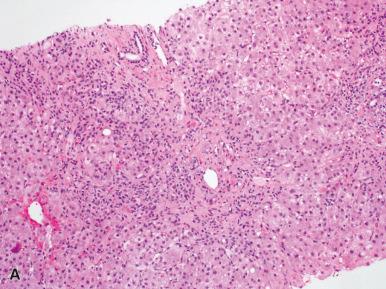
Acute hepatitis D can occur in the setting of acute co-infection with HBV or can be superimposed on chronic HBV. The histologic picture of HDV hepatitis is similar to that of other forms of hepatitis, and although it tends to be more severe, it cannot be reliably distinguished histologically from hepatitis B or C. In parts of South America and Africa, acute HDV infection has been associated with microvesicular change in hepatocytes ; this “spongiocytic change” or “morula cell degeneration” was attributed to accumulation of small lipid droplets in damaged hepatocytes.
Acute hepatitis E . Outbreaks of hepatitis E occur throughout the developing world, primarily transmitted by contaminated water. The epidemiology in industrialized countries is less well understood, although some cases appear to be zoonotic. Hepatitis E typically causes self-limited acute infection. Histologically it is characterized by a cholestatic type of hepatitis, with mixed portal infiltrate, ductular reaction, prominent bilirubinostasis, cholestatic rosettes, and marked apoptosis, bearing some resemblance to acute HAV.
Differential diagnosis . Acute viral hepatitis with marked cholestasis can be differentiated from obstructive forms of cholestasis by the lobular necroinflammatory lesions that are typical of acute viral hepatitis. Drug-induced hepatitis may be indistinguishable histologically from viral hepatitis; hence it follows that drug-induced liver disease should always be kept in mind when facing a case of acute hepatitis that is of questionable etiology. Features suggestive of a drug-induced lesion include sharply delineated centrilobular necrosis, abundant eosinophils, and granulomas (particularly microgranulomas); however, the absence of these features does not exclude drug-associated hepatitis. Autoimmune hepatitis can have an acute onset, histologically similar to viral hepatitis, but typically autoimmune hepatitis has more fibrosis and a more plasma cell-rich infiltrate than that seen in most cases of acute viral hepatitis.
Differentiation of acute from chronic viral hepatitis is generally based on the predominance of portal and periportal changes and fibrosis in the latter, whereas lobular lesions prevail in acute hepatitis, and fibrosis is typically not increased. However, the distinction may be very difficult, if not impossible, in the absence of clinical and laboratory data.
History and classification. The introduction of needle aspiration biopsy of the liver greatly contributed to the recognition of noncirrhotic forms of chronic inflammatory liver disease. In the 1960s, chronic hepatitis was presumed to be a sequel of viral hepatitis, although a causative agent had not been identified. Autoimmune hepatitis was considered to be the “classic” form of chronic active hepatitis at that time. Because of marked semantic confusion, a simple classification of chronic hepatitis, based on histology, was proposed by a group of hepatologists and pathologists in 1968. Because immunosuppression was the standard treatment, reserved for the more “active” forms of the disease, the classification distinguished between a milder form (chronic persistent hepatitis [CPH]) with a low degree of necroinflammatory activity, and more severe variants (chronic aggressive or active hepatitis [CAH]) featuring higher degrees of necroinflammatory activity. This classification of chronic hepatitis became widely accepted and was used worldwide for nearly 40 years. Although it was emphasized that CPH and CAH were not to be considered distinct disease entities, but as variations in the degree of disease activity, this message was frequently, and with the passage of time, increasingly, ignored.
Remarkable progress has been achieved in the elucidation of the multiple etiologies of chronic hepatitis since 1968, particularly with the discoveries of HBV, HCV, and HDV. A drug-induced form of chronic hepatitis was recognized in 1971 and is now established as a classic cause of the disease. Chronic autoimmune hepatitis remained a diagnostic category, with gradual refinements in clinical and serologic diagnosis. Wilson disease was also shown to resemble chronic hepatitis clinically and histologically in some cases ; the same appeared to apply to another metabolic disease, α1-AT deficiency. Furthermore, piecemeal necrosis, a very important diagnostic criterion in CAH, but (incorrectly) thought by some to be pathognomonic of and synonymous with chronic hepatitis, was also observed in chronic biliary diseases such as PBC and primary sclerosing cholangitis (PSC).
Investigations into the natural course of disease in chronic HBV infection revealed successive phases of viral replication, elimination, and integration, associated successively with less, higher, and again decreasing degrees of necroinflammatory disease activity. This implied the successive occurrence of CPH and CAH variants in individual patients over the course of their disease, confusing those who considered CPH and CAH to be distinct disease entities. This precipitated a change of view on chronic hepatitis. Most importantly, the development of more efficient treatment for chronic viral hepatitis (interferons and antiviral agents) urgently necessitated a revision of chronic hepatitis classification. In 1994, two proposals for a new classification of chronic hepatitis (both viral and other etiologies) were published. Both are largely parallel, although the latter includes chronic biliary and metabolic diseases (which may mimic chronic hepatitis) under that heading. There appears to be general agreement to restrict the term “chronic hepatitis” to its original meaning: a clinical and pathologic syndrome with several causes, characterized by varying degrees of hepatocellular necrosis and inflammation. For lack of a better definition of chronicity, chronic hepatitis is still defined (as in 1968) as a continuing disease (indicated by elevated liver tests) without improvement for at least 6 months.
In order to be comprehensive and clinically useful, these classifications consider: (1) the etiology; (2) the grade of disease activity; and (3) the stage of progression of the disease. The first question to be asked by the pathologist when classifying chronic hepatitis remains: “Is this chronic hepatitis, or another liver disease?” Several liver diseases may have clinical and histologic features resembling those of chronic hepatitis, as mentioned previously, and need to be considered in the differential diagnosis, but do not correspond to “chronic hepatitis” in its strictest sense. The second step concerns determination of the etiology, which cannot be based on histology alone and requires consideration of clinical and serologic data. Histopathologic study of the liver biopsy, however, may be useful in establishing, confirming, or refining an etiologic diagnosis. The next step corresponds to grading of disease activity, which is evaluated by clinical symptoms, by aminotransferase levels, and by histopathology of the liver biopsy. Histologically, the degree of disease activity is evaluated by considering the main components in the histopathologic picture: portal inflammation, interface hepatitis, lobular damage and inflammation, and confluent necrosis. Several systems can be utilized to express the degree of disease activity in the liver biopsy. In daily practice, an adequate report consists of an accurate estimate of the various lesions, described as minimal, mild, moderate, or severe. For specific purposes, such as comparison of pre- and post-treatment biopsy specimens and for evaluation of therapeutic trials, semiquantitative scoring systems may be indicated (see Grading and staging , later).
Staging of the disease is an attempt to place the patient's disease at a specific point in time along an assumed course or time of progression. The histologic evaluation of disease stage is based on the extent of fibrosis and the development of cirrhosis, which has significant prognostic and therapeutic implications. Connective tissue stains are essential for staging. As is the case for histologic grading, staging can also be expressed descriptively, which is an appropriate method for daily reporting of biopsies. Again, however, for specific purposes, semiquantitative scoring systems can be used (see later).
Histopathology. The basic lesions that compose the histopathologic picture of chronic hepatitis (viral and otherwise) include “spotty necrosis,” portal inflammation, interface hepatitis, and fibrosis. Occasionally confluent necrosis may be seen and, if disease progresses, parenchymal regeneration and cirrhosis. “Spotty necrosis” is an older term, loosely applied to apoptosis and genuine necrosis of single hepatocytes; this finding may also be seen in acute hepatitis (see earlier). A more appropriate morphologic term would be “focal necroinflammation,” recognizable as a small cluster of mononuclear cells (lymphocytes, possibly with histiocytes) with or without an adjacent identifiable apoptotic body or bodies. Spotty necrosis in chronic hepatitis looks the same as in acute hepatitis. Confluent parenchymal necrosis of the lytic type, or dropout of contiguous groups of hepatocytes with collapse of the reticulin framework, occurs in more severe forms of chronic hepatitis, and often coincides with clinical episodes of disease exacerbation. As in acute hepatitis, the extent of confluent necrosis may range from focal to zonal confluent necrosis to “bridging” confluent necrosis ( Fig. 19.7 ), and then to the more extensive panlobular and multilobular extent. Severe parenchymal necrosis is often accompanied by the development of small, glandlike clusters of surviving hepatocytes within the inflamed tissue ( Fig. 19.8 ). These “hepatitic rosettes” are usually surrounded by connective tissue, and presumably represent attempts at regeneration from surviving hepatocytes in an unfavorable environment.
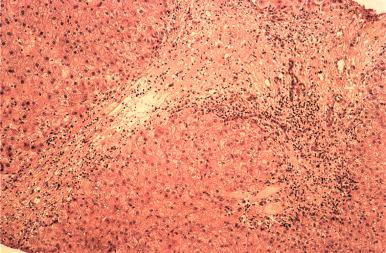
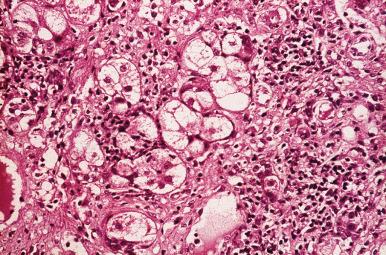
Portal inflammation in chronic hepatitis may be mild, moderate, or dense. It is predominantly composed of mononuclear cells, mainly lymphocytes, with variable numbers of plasma cells and histiocytes. Lymphoid aggregates and true lymphoid follicles may develop. Interface hepatitis was originally termed “piecemeal necrosis.” This term refers to the extension of the lymphocytic portal infiltrate beyond the limits of the portal tract, along with the death and “piecemeal” dropout of hepatocytes. Surviving hepatocytes are ultimately trapped within the inflammatory infiltrate, neoangiogenesis, and fibrosis, leading to an irregular portal/periportal interface ( Fig. 19.9 ). Interface hepatitis is thus a better term, particularly as the mode of liver cell death is apoptosis and not necrosis, and the lesion is located at the interface between mesenchyme (portal tract or septum) and parenchyma. Interface hepatitis may be mild (one or a few foci around the portal perimeter without noticeable fibrous extension), or severe (with wedge-shaped extension of the necroinflammatory lesion and obvious fibrosis deep into the lobule).
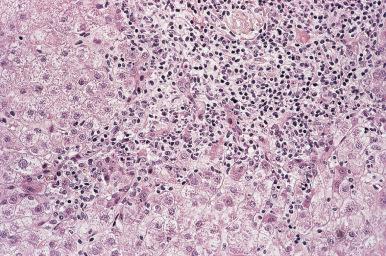
Interface hepatitis is responsible for the enlargement of portal tracts with irregular outlines in chronic hepatitis. The distinction should be made between true “lymphocytic piecemeal necrosis” as described previously, and “biliary piecemeal necrosis,” which occurs in chronic biliary disease. In the latter variety, the irregular outline of the enlarging portal tract is not due to “invading” lymphocytes but to ductular reaction with associated neutrophil infiltration and cholate stasis of periportal hepatocytes (see later).
Fibrosis may develop with ongoing inflammation. Septal fibrosis may occur as periportal, portal–portal and portal–central septa. Periportal and portal–portal septa presumably result from interface hepatitis, whereas portal–central septa seem to be sequels of portal–central (bridging) confluent necrosis. Ongoing necroinflammation, associated with progressive fibrosis and parenchymal regeneration, eventually leads to cirrhosis. Parenchymal regeneration results from multiplication of mature hepatocytes, and to a variable extent proliferation of hepatic progenitor cells. In the cirrhotic stage, the necroinflammatory changes may have subsided (inactive cirrhosis) or may continue unabated (active cirrhosis).
Grading and staging. Several systems for semiquantitative scoring have been proposed for evaluation of liver biopsies in chronic hepatitis ( Tables 19.2 and 19.3 ). Originally, the most widely used was the Histological Activity Index (the HAI or Knodell index) published in 1981. A simple scoring system was proposed by Scheuer and found to be easily applicable and reproducible. A “modified HAI” was published as an extension of the original Knodell system, with a series of modifications attempting to overcome some of the problems that had emerged in its use. This modified HAI has been validated for intra- and interobserver variability. For the evaluation of chronic hepatitis C, the system proposed by the French METAVIR Cooperative Study Group has been applied to very large numbers of biopsies, especially for staging purposes.
| CHANGE | SCORE |
|---|---|
| No fibrosis | 0 |
| Fibrous expansion of some portal areas, with or without short fibrous septa | 1 |
| Fibrous expansion of most portal areas, with or without short fibrous septa | 2 |
| Fibrous expansion of most portal areas with occasional portal–portal (P-P) bridging | 3 |
| Fibrous expansion of portal areas with marked bridging (portal–portal (P-P) as well as portal–central (P-C)) | 4 |
| Marked bridging (P-P and/or P-C) with occasional nodules (incomplete cirrhosis) | 5 |
| Cirrhosis, probable or definite | 6 |
| Maximum possible score in staging | 6 |
| GRADE | STAGE | ||
|---|---|---|---|
| 0 | No activity Portal inflammation only No interface activity No lobular activity |
0 | No fibrosis |
| 1 | Minimal activity Portal inflammation Minimal interface activity Occasional lobular apoptotic hepatocytes |
1 | Portal fibrosis (fibrous portal expansion) |
| 2 | Mild activity Interface activity involving some or all portal tracts Mild lobular activity with little hepatocyte damage |
2 | Periportal fibrosis (portal expansion plus periportal irregularity; rare portal/portal septa) |
| 3 | Moderate activity Interface activity involving all portal tracts Moderate lobular activity with obvious hepatocyte damage |
3 | Septal fibrosis (bridging fibrous septa with architectural distortion; no obvious nodularity) |
| 4 | Severe activity ± bridging necrosis Prominent diffuse hepatocyte damage |
4 | Cirrhosis |
Several papers have commented on the different scoring systems, with discussions of their advantages and disadvantages. One review considers all scoring systems for chronic hepatitis as well as for other liver diseases. The conclusion is that each of the systems currently in use has strengths and weaknesses, and all suffer from the problems that apply to any form of histologic scoring of liver biopsies in chronic hepatitis, including lack of scientific validation, observer variation, sample variation, and etiologic differences. In this era of evidence-based medicine, numerical scoring of liver biopsies continues to have a place, and the pathologist engaged in semiquantitative scoring of liver biopsies has plenty of published advice available in the literature. Numerical staging and grading is particularly useful for comparing pre- and post-treatment biopsies for a single patient; as a research method for studying the course of a disease; and for use in clinical therapeutic trials.
The need for estimating the degree of liver fibrosis in chronic viral hepatitis C in order to support treatment decisions has stimulated the search for noninvasive markers of liver fibrosis because of sampling variability in needle biopsies. A noninvasive technique that is being used with increasing frequency is transient elastography. Noninvasive methods have even been proposed as substitutes for liver biopsy; however, biopsy and noninvasive alternatives are not mutually exclusive options, and a clear understanding of the significance and limitations of each tool is required. The strengths and weaknesses of liver biopsy and of noninvasive markers were reviewed and their respective roles in management of patients with chronic hepatitis C discussed in a paper by P. Bedossa.
Chronic hepatitis B. During some stages of chronic infection with HBV, overload of some cellular compartments with viral antigens may be so extensive as to be recognizable by light microscopy, creating helpful diagnostic markers of disease. Two such markers are “ground-glass hepatocytes” and “sanded nuclei.” “Ground-glass hepatocytes” are parenchymal liver cells with a pale, homogeneous, more finely granular appearance in part or all of their cytoplasm; the “ground-glass” area is often separated from the cell membrane by a clear halo, which is an artifact, albeit a helpful one ( Fig. 19.10A and B ). The ground glass appearance is due to marked hypertrophy of the smooth endoplasmic reticulum, which displaces the cytoplasmic organelles to the periphery of the cell, and which contains excess filamentous structures of HBsAg in its cisternae. This ground-glass appearance of hepatocytes is, however, not entirely specific, and also occurs in other liver diseases, including drug-induced hypertrophy of the smooth endoplasmic reticulum (which predominates in centrilobular hepatocytes) ; fibrinogen storage disease, in which fibrinogen inclusions in parenchymal cells in patients with hypofibrinogenemia resemble ground-glass hepatocytes ; Lafora disease (myoclonus epilepsy) ; glycogenosis type IV (amylopectinosis or Andersen disease) ; and abnormal glycogen metabolism in polypharmacotherapy or following liver transplantation. Ground-glass hepatocytes from several causes may, in fact, coexist in the same biopsy.
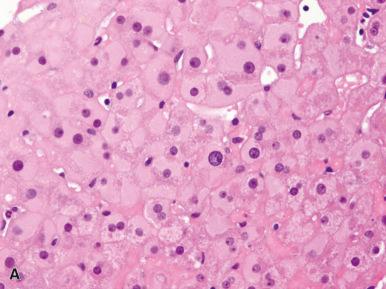
Special stains such as Shikata orcein stain, Victoria blue, and aldehyde fuchsin confirm the HBsAg relationship of the ground-glass appearance, and even more convincing is immunohistochemical staining with specific anti-HBsAg antibody. Sanded nuclei are hepatocellular nuclei with a finely granular, pale eosinophilic appearance in the larger central part of the nucleus, due to massive accumulation of HBcAg. They are not easily recognized, and specific immunohistochemistry is far more helpful in identifying HBcAg.
The clinical, histopathologic, and immunohistochemical findings in chronic HBV have been summarized in several overviews ; they vary over the course of the disease depending on viral load, quality of immune response, and possibly associated comorbidity. Under most circumstances, HBV is not cytopathic, and it is the immune response of the host that determines the outcome of infection. The most complete immune response is associated with the most severe liver injury and the greatest likelihood of viral clearance, whereas an immature immune response leads to chronic hepatitis. The natural history of chronic HBV has been viewed in four stages by some authors, and three stages by other, earlier workers.
The first stage is characterized by high viral loads and immune tolerance. In acute infection, this corresponds to the incubation period, but with neonatal chronic infection, this period often lasts for decades. During the early viral replication and immune tolerance phase in chronic hepatitis, liver biopsy reveals only minimal hepatocellular damage and inflammation. Immunohistochemically, this viral replicative phase is characterized by nuclear and cytoplasmic localization of HBcAg and HBeAg, which also localize in the liver cell membranes ( Fig. 19.11 ). HBsAg is found in the cytoplasm of some scattered hepatocytes and in the membrane of numerous parenchymal cells, revealing a honeycomb-like pattern ( Fig. 19.12 ). The second stage, or viral elimination phase, is characterized by immune clearance of hepatocytes, histologically correlating to hepatocyte necrosis. Liver biopsy reveals necroinflammatory lesions, including confluent lytic necrosis of variable extent in more severe cases. Immunostaining reveals nuclear, cytoplasmic, and membranous staining for HBcAg; HBsAg appears as weak positivity in the cytoplasm of some hepatocytes, associated with a membranous staining pattern. HBeAg staining reveals nuclear and cytoplasmic localization. In patients with chronic infection, stage 2 may persist for 10–20 years and lead to cirrhosis and its complications.
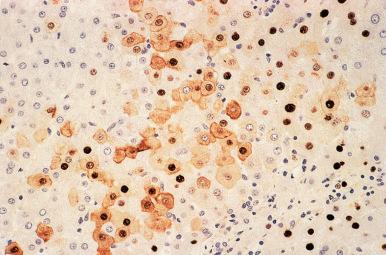
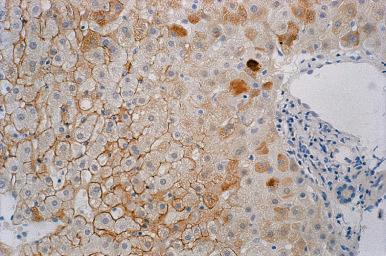
When the immune response decreases the number of infected cells, a third stage featuring low viral replication begins, referred to as the “inactive carrier” state. In this stage, HBeAg is no longer detectable and antibody to HBeAg becomes detectable. A marked decrease in HBV viral load is observed, and although many patients remain positive for HBV DNA, it is only detectable by polymerase chain reaction (PCR) and aminotransferase levels become normal. Active replication of HBV has ceased, but HBsAg is continuously produced by liver cells that contain integrated HBV genome and the patient becomes an HBsAg carrier (viral integration phase). HBsAg accumulates in clusters of hepatocytes, appearing as ground-glass cells or staining in the periphery of parenchymal cells ( Fig. 19.13 ). HBcAg is usually absent. Mild inflammation may persist for some time after loss of HBsAg in the serum, but substantial necroinflammation at this stage should raise the possibility of superinfection with another virus. The annual negativation (i.e., spontaneous return to seronegativity) rate for HBV surface antigen is approximately 1%.
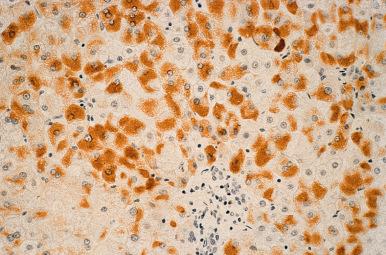
Some patients continue to have high levels of serum HBV DNA and aminotransferases (stage 4, referred to as HBeAg-negative chronic hepatitis), due to precore mutant HBV variants characterized by deficient synthesis of the immune tolerogen HBeAg. Immunostaining then reveals cytoplasmic HBcAg.
If the patient's immune system succeeds in eliminating the virus, the fibrogenesis/fibrolysis balance may change in the direction of the latter, resulting in regression of fibrosis to considerable extent due to the action of metalloproteinases from hepatic stellate cells and hepatocytes. During stage 4, some patients can reactivate their HBV when given chemotherapy or immunosuppressive treatment. Patients with active HBV replication are at increased risk for cirrhosis, hepatic decompensation, and hepatocellular carcinoma compared to inactive carriers. Available evidence indicates that control of HBV replication with antiviral agents decreases the incidence of these complications.
Cirrhosis developing in the viral integration phase of HBV will progress slowly over 20–30 years, eventually with decompensation and other complications. Initially micronodular, the cirrhosis becomes more macronodular, and hepatocellular carcinoma may develop as a further consequence (see also Chapter 20 ). Even in patients without cirrhosis in the integration phase (so-called healthy HBsAg carriers), the risk for developing hepatocellular carcinoma is higher than in noncarriers.
Chronic hepatitis B + D. Chronic hepatitis D is in decline in Italy, but not in the rest of Europe, and it remains a major health problem in the many underdeveloped areas of the world where HBV is uncontrolled. Chronic hepatitis D tends to be more severe, with higher activity and risk of progression, than chronic HBV alone. Rapid progression to cirrhosis is the fate in a minority of patients; more commonly, the disease evolution is slow and insidious, evolving into cirrhosis over many years. HDV selectively suppresses HBcAg and HBeAg, but not HBsAg, although it depends on low-grade HBV multiplication and release. Immunohistochemically, HDAg is found mainly in liver cell nuclei, which may show a sanded appearance due to excess HDAg, and in the cytoplasm and membranes of hepatocytes. Double immunostaining for HBV and HDV antigens often shows separate expression of HDAg versus HBsAg or HBcAg, but coexpression does occur.
Chronic hepatitis C. HCV infection is characterized by a silent onset in most infected individuals, a high rate of viral persistence, and the potential for development of chronic liver disease, ranging from chronic hepatitis to cirrhosis and occasionally to hepatocellular carcinoma. The sheer magnitude of the infected population will result in a large number with severe, life-threatening disease, thus rendering chronic HCV infection, with 170 million chronically infected people, a staggering worldwide problem.
Histologically, chronic HCV is often mild initially, with little parenchymal damage other than focal inflammation and hepatocellular apoptosis. A carrier state with normal liver biopsy has been reported, and conversely abnormal liver histology has been recorded in HCV RNA-positive patients with normal serum alanine aminotransferase. The histopathology of chronic HCV, although not pathognomonic, is highly characteristic, and several reviews are available.
The portal infiltrate is rich in lymphocytes, often forming lymphoid aggregates ( Fig. 19.14 ) and even follicles with prominent germinal centers. Lymphoid follicles are not specific for chronic HCV, however, and are also found in HBV, autoimmune hepatitis, and PBC. Nevertheless, they are particularly prominent in hepatitis C. Lesions of interlobular bile ducts are not uncommon ( Fig. 19.15 ), with frequencies ranging from 15%–91% of biopsies. This broad variation likely indicates a poor consensus on the definition of “bile duct lesion.” The most frequently observed bile duct lesions consist of infiltration of the bile duct epithelium by lymphocytes, with variable degrees of cytoplasmic vacuolization, nuclear stratification, and crowding of the biliary ductal epithelial cells. The most pronounced bile duct lesion, originally described before HCV was even discovered, is characterized by swelling and stratification of bile duct lining cells and infiltration by lymphocytes, yet preservation of the basement membrane of the bile duct. This type of bile duct lesion must be differentiated from that occurring in PBC, which tends to be more destructive, but on occasion the distinction may be difficult.
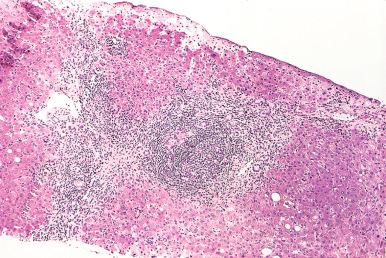
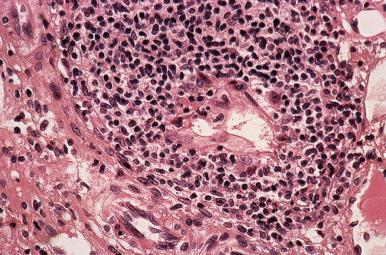
The lobule in chronic HCV may contain a striking number of acidophil bodies. Oxyphil granular hepatocytes (or oncocytes, cells rich in mitochondria) have been reported in more than a third of biopsies. There is typically patchy lymphocytic infiltration with spotty necrosis; the lymphocytic infiltrate may form rows along the sinusoids (so-called Indian file) resembling hepatic mononucleosis. Mild to moderate steatosis, usually of the macrovesicular type, has been described in frequencies ranging from 40% to 80% ( Fig. 19.16 ), depending on the features of the population studied in terms of alcohol consumption and prevalence of other risk factors for fatty liver including obesity and diabetes. Steatosis is more frequent and more severe in patients with genotype 3. HCV interferes with lipid metabolism via at least three ways, which are not mutually exclusive: impaired secretion of lipid, impaired degradation, and increased synthesis. Steatosis favors viral replication, since the lipid droplet represents an organelle that functions as an assembly platform for the different viral components (HCV core, functional replication complexes, viral RNA, envelope proteins). Steatosis is believed secondary to direct viral effect in patients with genotype 3, but is likely secondary to insulin resistance and/or alcohol use in patients infected with other genotypes. Steatosis and steatohepatitis in chronic hepatitis C are also associated with more inflammatory activity and faster fibrosis progression. Insulin resistance appears to be a specific feature of chronic HCV (much less so than in chronic HBV) and is particularly associated with genotypes 1 and 4 and high HCV RNA levels. Thus, it appears that chronic HCV, non-alcoholic steatohepatitis (NASH) and NAFLD may have mutual reinforcing effects: HCV genotype 3 infection may potentiate NAFLD/NASH by providing the “first hit” (steatosis) and by inducing insulin resistance, whereas on the other hand, NAFLD/NASH may potentiate HCV replication by providing fat droplets as scaffold for viral assembly. Bedossa et al. also found that in patients with NASH and chronic HCV of genotype 3 there was no associated metabolic syndrome, suggesting that NASH may complicate steatosis in chronic HCV irrespective of the etiology of the steatosis.
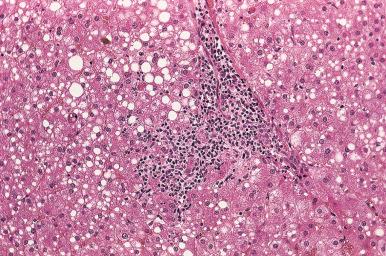
A number of other histologic alterations in chronic HCV infection have been described. Periportal hepatocytes may contain coarse clumps of eosinophilic cytoplasm, resembling Mallory–Denk bodies (MDBs). Venous lesions resembling the endotheliitis observed in acute cellular liver allograft rejection have also been reported and may further confuse the already difficult distinction between those two conditions. Increased amounts of hepatic iron have been reported in patients with chronic hepatitis C, even in the absence of a history of blood transfusion or alcohol abuse, and iron overload has been shown to impair response to interferon therapy. Increased hepatic iron in the context of chronic hepatitis C, however, may also be due to associated hemochromatosis, porphyria cutanea tarda (PCT), alcohol abuse, oral iron intake, and previous treatment with ribavirin.
Another confusing lesion is the occurrence of epithelioid granulomas in a small minority (5%) of cases, sometimes as a transient feature. The development of granulomas has been correlated with interferon-α therapy and has been associated with both favorable and adverse responses to therapy. In the post-transplant setting, granulomas have been observed in association with pegylated interferon-treated recurrent viral hepatitis C. Of course, other causes of granulomas must be excluded before the etiology of the granulomas is attributed to hepatitis C. The presence of epithelioid granulomas may also render the distinction of chronic HCV from PBC more difficult, particularly if lymphocytic cholangitis and mild epithelial damage is present (see earlier). A rare case of fibrin-ring granuloma has also been reported.
Syncytial giant cell hepatitis is a rare histologic finding among HIV-infected patients with chronic hepatitis C; specific treatment with pegylated interferon and ribavirin can lead to its histologic resolution.
The natural history of chronic hepatitis C is one of progressive fibrosis, even in cases with mild disease. Adverse risk factors for progression include young age at infection, infection acquired via intravenous drug abuse, and HCV genotype 3. It has also been noted that in HCV-infected children, inflammation, fibrosis, and steatosis were milder than in treatment-naive HCV-infected adults, but there were still several cases with bridging fibrosis or cirrhosis. The positive correlation of inflammation with duration of infection and fibrosis, as well as the correlation between obesity/metabolic syndrome and fibrosis, suggests that children with chronic hepatitis C will be at risk for progressive liver disease as they age and possibly acquire other comorbid risk factors.
A strong correlation has also been noted between portal fibrosis and periportal ductular reaction (hepatic progenitor cell expansion), exacerbated by steatosis and associated with impaired hepatocyte replication, suggesting that an altered regeneration pathway may drive ductular reaction, which in turn triggers fibrosis at the portal tract interface. Portal and periductal macrophages expressing matrix metalloproteinase-9 have also been associated with increased ductular reaction and progression of fibrosis. Greater inflammatory activity has also been associated with disease progression.
As noted previously, demonstration of viral antigens by immunohistochemistry has been reported in multiple studies, but reproducible and clinically useful results in paraffin-embedded material have been lacking. The same criticism regarding specificity applies to ISH for HCV RNA.
Combined pathology in chronic viral hepatitis. Combined infection with HBV and HCV increases the severity of the histologic liver lesions. Triple infection with HBV, HDV, and HCV results in severe disease in the acute superinfection stage; however, the overall course is relatively benign, slowly progressive, and usually dominated by HCV. HIV infection may result in reactivation of HBV, with higher levels of HBV replication and more immunocytochemically demonstrable HBcAg and HBeAg, but typically without an increase in necroinflammation. Necroinflammatory activity is also higher in HIV-positive patients with chronic hepatitis C, and cirrhosis is more frequent. The combination of steatosis, steatohepatitis, HIV, and HCV infection is associated with a more advanced degree of fibrosis as well. Infection with multiple hepatitis viruses is quite common and may be difficult to histologically diagnose without knowledge of pertinent clinical and laboratory data.
Foci of hepatocellular hemosiderosis (iron-rich foci) have been described in both chronic HCV and HBV, highlighting the potential for irregular iron storage in chronic viral liver disease and potential confusion with genetic hemochromatosis. Heterozygosity for hereditary hemochromatosis and hepatic iron overload in the context of chronic viral hepatitis may also influence progression toward liver fibrosis.
Some patients with chronic HCV have autoimmune features, including a greater degree of inflammatory activity (often with prominent plasma cells), positive autoimmune serological markers, higher levels of immunoglobulins, and an association with HLA-DR3. These patients have a greater frequency of cirrhosis.
Chronic infection with HBV and HCV can certainly occur in patients with many other unrelated liver diseases, such as PBC, PSC, and alcohol-related liver injury.
Several viruses not belonging to the group of specific “hepatitis” viruses discussed earlier may also induce liver inflammation, as either a primary disease or, more often, as part of systemic infection.
CMV infection . CMV is an important cause of opportunistic hepatitis in immunodeficient patients, particularly transplant patients and HIV-positive patients, and it also causes neonatal hepatitis. CMV inclusions may occur in any type of hepatic cell, including hepatocytes, bile duct cells, endothelial cells, and portal fibroblasts ; nuclear inclusions may have the typical “owl's eye” morphology, whereas cytoplasmic inclusions are often basophilic and granular ( Fig. 19.17A and B ). CMV immunohistochemistry may be very helpful in identifying inclusions, particularly when inclusions are not well formed. Neutrophilic microabscesses or aggregation of neutrophils in sinusoids is a useful diagnostic feature that should prompt a diligent search for viral inclusions or antigens. In immunocompetent patients a picture resembling EBV-associated hepatitis may occur (see later).
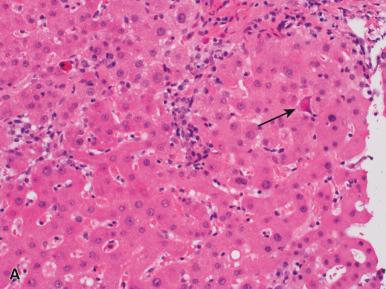
Infectious mononucleosis. EBV infection deserves consideration in the differential diagnosis in all age groups. The liver is affected in over 90% of patients with infectious mononucleosis, although this is often subclinical. Symptomatic liver involvement develops in only 5%–10% of patients. ISH is a useful ancillary tool in confirming the diagnosis of EBV hepatitis in equivocal cases; however, EBER-positive cells can be sparse and easily overlooked. Histologically, dense mononuclear infiltrates, often containing large atypical lymphocytes, are found in portal tracts and sinusoids. In the latter, they spread in a distinctive single-file, “string-of-beads” or “Indian-file” array ( Fig. 19.18 ). Kupffer cells are hypertrophic, and epithelioid and fibrin-ring granulomas are occasionally found. Small foci of hepatocellular necrosis and acidophil bodies may be seen, but generally the parenchymal damage is not in proportion withthe density of the infiltrate. Cholestatic hepatitis may also be encountered, albeit rarely. Occasionally EBV-associated hepatitis must be distinguished from hepatic involvement by leukemia or lymphoma.
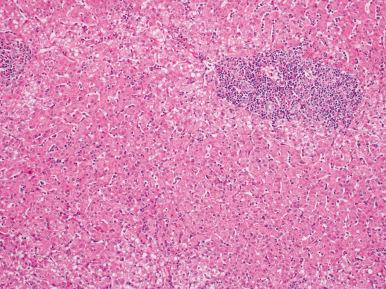
Acquired immunodeficiency syndrome (AIDS). A wide spectrum of liver abnormalities may be observed in AIDS and HIV infection. Although Kupffer cells can serve as a reservoir for HIV, the liver is not a primary target of HIV infection, and most of the hepatic manifestations reflect opportunistic infections, lymphoma, and Kaposi sarcoma. The patterns of opportunistic infection vary significantly in different parts of the world, depending on the local prevalence of infection, as well as on the availability of treatment and thus the survival of HIV-infected patients. It is also important to recognize that the pathologist may encounter an opportunistic infection well outside its usual geographic distribution, due to travel or immigration. Hepatic involvement by CMV is quite common (see earlier) ; other opportunistic infections involving the liver and bile ducts in AIDS patients include Mycobacterium avium intracellulare , Mycobacterium tuberculosis , Cryptococcus species, Candida species, Histoplasma , and malaria. A frequently encountered hepatic lesion is the occurrence of multiple granulomas containing Mycobacterium avium-intracellulare , visualized to better advantage by PAS–diastase, Ziehl–Neelsen, or Gomori methenamine silver stains. The mycobacteria are packed in the foamy histiocytes that constitute the granulomas and often show a striated appearance ( Fig. 19.19A and B ). Small numbers or even single mycobacteria may also be present in scattered Kupffer cells. Pneumocystis carinii may cause multiple foci of eosinophilic foamy exudate, similar to that seen in pulmonary infection. Bartonella henselae -associated bacillary angiomatosis may also be seen.
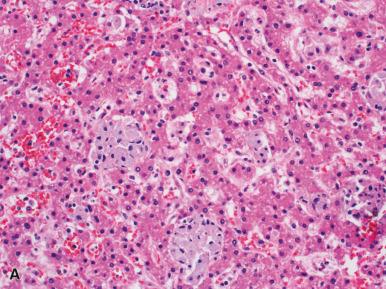
Nonspecific histologic changes can also be found in the livers of patients with HIV, including mild mononuclear portal inflammation, scattered lobular lymphocytes and apoptotic bodies, fibrosis, ductular reaction, steatosis, and Kupffer cell siderosis. Lipid-laden perisinusoidal hepatic stellate cells have also been reported in AIDS.
AIDS-associated cholangiopathy is an important biliary disorder caused by opportunistic infection of the biliary epithelium, which resembles sclerosing cholangitis. Microsporidia and Cryptosporidia are two such biliary pathogens. CMV-associated ductopenia has also been reported as a cause of vanishing bile duct syndrome in an AIDS patient with signs and symptoms of obstructive jaundice and cholestasis.
A number of noninfectious lesions occur in this patient population as well. Hepatoportal sclerosis (HPS) , characterized by varying degrees of portal fibrosis, sclerosis of portal vein branches and dilation of sinusoidal spaces (see also later), has been identified as a cause of noncirrhotic portal hypertension in patients with HIV. Highly active antiretroviral therapy (HAART) is also a cause of hepatotoxicity and may cause fatty liver disease as well as other patterns of liver injury. From a neoplastic standpoint, non-Hodgkin lymphomas , especially of the Burkitt and immunoblastic types, may involve the liver, occurring as portal infiltrates or as nodular masses. Hepatic involvement by Kaposi sarcoma also occurs.
The frequent occurrence of adverse drug reactions and toxic damage to the liver is not surprising, as this organ is the main site of biotransformation of endo- and xenobiotics. The incidence is high, with an estimated incidence of up to 14 cases per 100,000 inhabitants in France ; drug-induced liver injury (DILI) is also the leading cause of acute liver failure in the United States.
Recognition of DILI is challenging for several reasons. It can mimic virtually any other type of liver disease, and clinical signs of a hypersensitivity reaction may not occur in all cases. DILI can occur with drugs from all classes, and the same drug may cause different patterns of liver damage in different patients ; for example, mitochondrial dysfunction, a major mechanism of liver injury, may cause fulminant hepatitis, micro- and macrovesicular steatosis, or steatohepatitis. It is often impossible to pinpoint the causative agent in patients on multiple drug therapy, which usually is the case in elderly patients, and a patient's drug history is often far from reliable. DILI may also be potentiated by the concomitant administration of other pharmacologic agents. Furthermore, hepatotoxicity may not yet have been reported for the drug in question, even when it has been on the market for a long time. Besides medicinal drugs, one also has to consider hepatotoxicity from herbs and dietary supplements.
The pathologist should be aware of the types of lesion most likely to be induced by drugs, and how to try to differentiate these from features less likely to be caused by drugs. Although it is useful to be aware of specific sources of information such as books and comprehensive reviews on this subject, because of the growing diversity of drugs, current information is often more accessible on PubMed and other internet sources.
A distinction has been made between predictable (or intrinsic, or drug-dependent) toxicity effects on the one hand, and unpredictable (or hypersensitive, or idiosyncratic, or host-dependent) reactions on the other hand. Predictable reactions are due to the intrinsic hepatotoxicity of the molecule, are typically dose dependent and occur in all exposed individuals, occur with a relatively short (though variable) latent period, and are reproducible in experimental animals. Acetaminophen overdose is an example of this type of toxicity. Of far more concern is the more frequent, unpredictable type of DILI. It occurs in only a small fraction of the population exposed, there is no clear dose relationship, the latent period may be quite long (weeks or months), and it is not reproducible in experimental animals. Exceptional sensitivity to a particular drug may be based on genetically determined differences in drug metabolism (“metabolic idiosyncrasy”) or to immunologically based reactions to neoantigens formed by interaction between a drug metabolite and some tissue or cell membrane component (“immunoallergic idiosyncrasy”). The latter mechanism is believed to be the most frequent type of idiosyncratic DILI.
Conclusive proof that a particular drug or combination of drugs is responsible for DILI in an individual case is often impossible to obtain; rechallenge would be an obvious effective test but is clearly unethical. Inadvertent rechallenge may provide strong circumstantial evidence, even many years after a first episode.
Drug-induced adverse reactions in the liver may cause structural and functional changes in all cellular components of the organ, which then coalesce to produce various patterns of injury. Individual histologic features, as well as patterns of drug-induced injury, are briefly summarized next.
Hepatocytes . In view of the parenchymal heterogeneity in the liver lobule, with predominance of microsomal biotransformation enzymes in the centrilobular zone, it is not surprising that drug-induced effects may show a zonal distribution or predominance.
A ground-glass appearance of hepatocytes in the centrilobular area, due to hypertrophy of the smooth endoplasmic reticulum (similar to that seen in chronic HBV infection, see earlier) with associated enzyme induction, can be caused by a number of drugs such as phenobarbital, rifampin, dioxin, and cyanamide.
Lipofuscinosis, or increased accumulation of lipofuscin (wear and tear pigment) in centrilobular hepatocytes is induced by prolonged intake of some drugs such as phenacetin, aminopyrine (aminophenazone), chlorpromazine, Cascara sagrada, and by anticonvulsant therapy. It must be differentiated from the pigment accumulation in Dubin–Johnson syndrome.
Steatosis (see also later) is a frequently occurring effect of xenobiotics. Macrovesicular steatosis can be seen with drugs such as tamoxifen, estrogens, methotrexate, and ethanol. Microvesicular steatosis may be associated with clinical manifestations of severe liver injury, even in the absence of overt hepatocellular necrosis. It is apparently due to inhibition of mitochondrial fatty acid β-oxidation and mitochondrial dysfunction. It has been associated with intravenous tetracycline, amiodarone, valproate, and acetyl salicylate in children (Reye syndrome). Microvesicular steatosis has also been reported with several antiviral nucleoside analogs (e.g., fialuridine). A similar alteration is observed in mitochondriopathies and in acute fatty liver of pregnancy (AFLP).
Phospholipidosis is characterized by foamy cytoplasmic vacuoles and enlargement of hepatocytes and Kupffer cells due to phospholipid accumulation. Electron microscopy reveals lamellated myeloid bodies (fingerprints) in enlarged lysosomes. Associated drugs include gentamycin, perhexiline maleate, fluoxetine, and amiodarone ( Fig. 19.20 ) ; drug toxicity from the latter may even lead to cirrhosis.
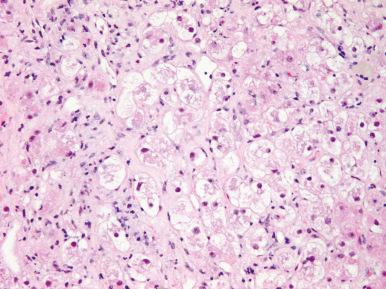
Reactive hepatocellular changes . Binucleated hepatocytes increase in number with sulindac, and multinucleated hepatocytes have been reported in several instances of acute and chronic drug-induced hepatitis (e.g., clometacin).
Hepatocellular death: apoptosis and necrosis . Both modes of hepatocellular death may be induced by toxic drug metabolites and immunoallergic hypersensitivity reactions. Hepatocellular necrosis may be variable in appearance (coagulative or lytic), in topography (centrilobular or periportal), and in extent (focal, zonal, bridging, lobular, or multilobular). With larger doses, many hepatotoxic drugs (e.g., chloroform, acetaminophen) and hepatic poisons (e.g., the mushroom Amanita phalloides , carbon tetrachloride) produce centrilobular necrosis, often associated with ballooning and steatosis in adjacent non-necrotic parenchymal cells, and with minimal or no inflammation. Other chemicals (e.g., ferrous sulfate, the yellow form of inorganic phosphorus) may cause periportal necrosis. Many of these agents cause fatal massive necrosis when administered in sufficient doses; in smaller doses, apoptosis of liver cells occurs, which, with time, may result in fibrosis and cirrhosis.
Kupffer cells are involved in storage of foreign materials and in granuloma development. Materials stored in Kupffer cells include talc and cellulose in drug addicts, silica and anthracotic pigment in coal miners, polyvinyl pyrrolidone and hydroxyethyl starch from infusion of plasma expanders, and silicone from prosthetic heart valve devices.
Numerous drugs—amongst them sulfonamides, methyldopa, and phenylbutazone—have been incriminated in the production of hepatic granulomas . A special variant, the fibrin ring granuloma , can be seen in hypersensitivity to allopurinol. Mineral oil granulomas are composed of lipophages and occur in portal tracts and near central veins. They have been attributed to the absorption and deposition of mineral oil taken as a medicinal agent (laxative) or ingested as a food additive or food contaminant from food packaging. Gold has been identified in lipophages and granulomas in patients who received gold therapy for rheumatoid arthritis.
Vascular changes . Periportal sinusoidal dilation has been related to oral contraceptive use. Peliosis hepatis (see also later) has been associated with the administration of anabolic–androgenic steroids, contraceptive steroids, and azathioprine. Sinusoidal obstruction syndrome (SOS; formerly known as veno-occlusive disease) , characterized by nonthrombotic narrowing of central vein lumina by loose connective tissue, is associated with pyrrolizidine alkaloids, radiation, conditioning for bone marrow transplantation, and chemotherapeutic agents, (e.g., irinotecan and oxaliplatin). Thrombosis of hepatic veins (Budd–Chiari syndrome [BCS]) and of portal vein branches is a rare complication of contraceptive steroids. Phlebosclerosis of portal vein branches (HPS) has been associated with long-term use of inorganic arsenicals (Fowler solution), Thorotrast, vinyl chloride, vitamin A, and methotrexate. Arteritis due to drug hypersensitivity may affect intrahepatic branches of the hepatic artery, resulting in multifocal hemorrhagic necrosis and exceptionally rupture of the liver. Angiosarcoma has been associated with inorganic arsenicals, Thorotrast, anabolic–androgenic steroids, cyclophosphamide, oral contraceptives, vinyl chloride, and radium therapy.
Hepatic stellate cell (Ito cell) hyperplasia , corresponding to an increased number of hepatic stellate cells ( Fig. 19.21 ), has been associated with a number of drugs including hypervitaminosis A, niacin, and in patients undergoing methotrexate therapy, although to less extent than once thought. Hepatic stellate cell hyperplasia may lead to increased fibrosis.
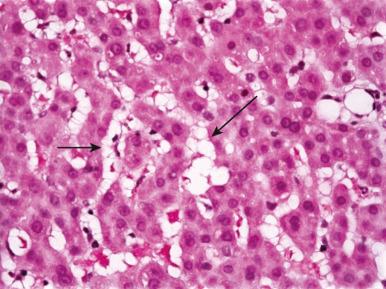
Cholestatic reactions are the most frequent side effects of drugs overall. Simple drug-induced cholestasis is histologically characterized by bland bilirubinostasis without accompanying inflammation ( Fig. 19.22 ). Such “simple” or “pure” cholestasis is seen with many drugs, the prototypes being anabolic and contraceptive steroids.
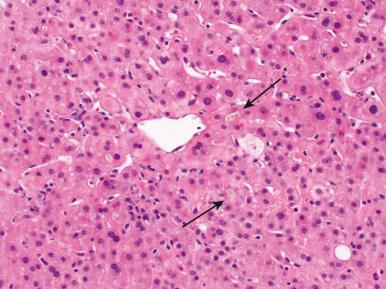
Bile duct damage and ductopenia may be due to the effects of many drugs. Because of the ductopenia, cholestasis of this type is usually prolonged, and may last for months and even years. The mechanism may be direct toxicity to bile duct cells or immunoallergic injury. Ductopenia has been reported in association with a large number of drugs, including chlorpromazine, haloperidol, ajmaline, glycyrrhizin, and several antibiotics.
Drug-induced acute hepatitis typically features hepatocellular damage and apoptosis/necrosis (variable in degree) with varying degrees of portal and lobular inflammation ( Fig. 19.23A and B ). Reactive hepatocellular changes and prominent Kupffer cells are also frequently seen, and cholestasis may be present as well. Eosinophils may or may not be prominent in the inflammatory infiltrate. Fibrosis is absent. Numerous drugs of diverse classes can cause this reaction; classic examples include isoniazid (a tuberculostatic agent), ibuprofen, halothane (an anesthetic), phenytoin, and sulfonamides. The histopathology is virtually indistinguishable from that of other forms of acute hepatitis, including acute viral hepatitis.
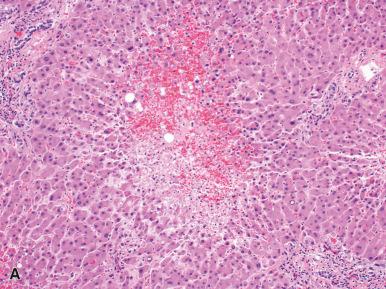
Drug-induced chronic hepatitis occurs in a minority (5%–10%) of patients. The histologic features can mimic several other types of chronic liver disease, including autoimmune hepatitis (e.g., minocycline and nitrofurantoin) and chronic viral hepatitis (phenytoin). Serologically, the presence of autoantibodies in cases of drug-induced autoimmune hepatitis may cause further confusion with de novo autoimmune hepatitis. The diagnosis relies on a high degree of suspicion of a possible drug etiology in the absence of viral markers, and close cooperation with clinician and patient. Recognition of this pattern of DILI is important, as withdrawal of the drug is often essential to treatment and prognosis.
Drug-induced steatohepatitis is rarely caused directly by the offending pharmaceutical; more often, the drug exacerbates or initiates steatohepatitis in the context of other risk factors for fatty liver disease. Associated drugs include amiodarone, antiretroviral therapy, irinotecan, and parenteral nutrition (total parenteral nutrition [TPN]; Fig. 19.24A and B ).
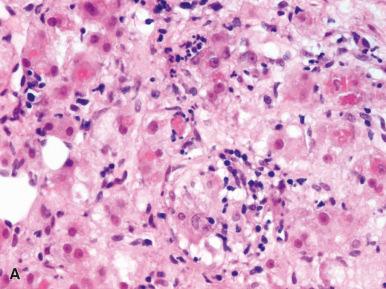
Drug-induced cholestatic hepatitis combines features of acute drug-induced hepatitis with cholestasis and variably present ductular reaction. Differentiation from large bile duct obstruction can be very difficult. Portal edema and neutrophilic cholangitis favor large bile duct obstruction but are not always present, and correlation with medication history is often essential. Although most cholestatic drug reactions resolve when the offending agent is discontinued, some cases become chronic, with associated interlobular bile duct damage and occasionally ductopenia ( Fig. 19.25A–C ). A number of antibiotics as well as antifungals and ACE-inhibitors have been associated with cholestatic drug reactions.
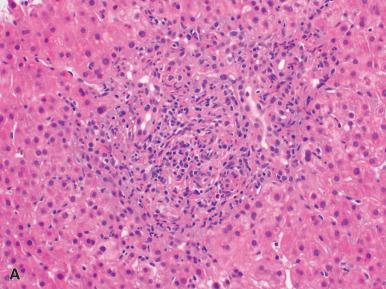
Drug-induced granulomatous hepatitis typically features noncaseating granulomas that can be present in portal tracts, lobules, or both ( Fig. 19.26A ). Cholestasis and an eosinophilic infiltrate may be helpful clues indicating DILI in addition to the granulomas ( Fig. 19.26B ). As mentioned previously, fibrin ring granulomas may also represent DILI.
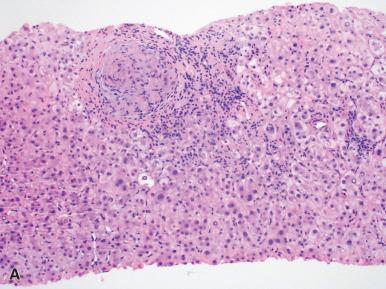
TPN-associated liver disease is worthy of additional mention given the frequency of occurrence, particularly in the pediatric population. TPN-associated liver disease develops in 40%–60% of infants and 15%–40% of adults who require long-term TPN. The spectrum of injury includes hepatic steatosis, cholestasis (which occurs more frequently in children than adults), cholelithiasis, and hepatic fibrosis. Progression to biliary cirrhosis and the development of portal hypertension and liver failure occur in a minority but are also more common in infants and neonates than in adults. In infants, histologic features include canalicular cholestasis, cholestatic liver cell rosettes, and ductular cholestasis ( Fig. 19.27 ). Giant hepatocytes and ductular reaction may also occur. The portal tracts variably contain a mixed inflammatory infiltrate, and with longer duration of TPN, periportal fibrosis develops. In adults, TPN may lead to steatosis, cholestasis, and periportal fibrosis as well, with periportal copper accumulation (sometimes marked) that is independent of the total duration of TPN. In infants requiring TPN, the liver histology may mimic other cholestatic diseases of infancy, including neonatal hepatitis and biliary atresia (BA).
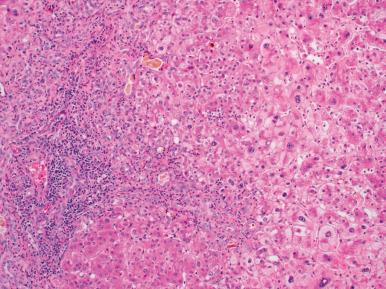
Diagnostic hints for the histopathologist. One should always maintain a high degree of suspicion for a drug-induced etiology, especially in elderly patients. A histologic picture resembling viral hepatitis, but with a disproportionately severe degree of parenchymal necrosis in relation to the patient's clinical condition, or with associated steatosis, granulomas, an eosinophilic infiltrate, or associated bile duct damage, should arouse suspicion for drug-induced disease. The same applies for centrilobular necrosis sharply delineated from non-necrotic parenchyma, especially if associated with steatosis, with only mild or minimal inflammation, and with numerous ceroid macrophages. Parenchymal giant cell hepatitis in adult patients, and the association of hepatocyte necrosis with SOS, should also act as an alert for a drug-induced etiology. The final conclusion concerning the diagnosis of drug-induced and toxic liver damage is that it can mimic a wide variety of other liver diseases and thus requires a sustained high degree of suspicion and alertness on the part of both the clinician and the pathologist. An impressive example is the detective story of the Epping jaundice, caused by chemically contaminated daily bread.
Steatosis (fatty liver, fatty change) corresponds to accumulation of triglycerides in the cytoplasm of hepatocytes. It is a frequent finding and represents a manifestation of reversible cell injury. Steatosis is a nonspecific lesion induced by a variety of causes. The degree of lipid accumulation is variable, ranging from occasional fat droplets to diffuse deposition involving most parenchymal cells. Histologically, in routinely fixed tissue, steatosis is represented by cytoplasmic vacuoles left behind when lipid is dissolved during processing. Very small droplet steatosis may be difficult to recognize, and thus histochemical staining may be helpful. Lipid can be demonstrated in frozen sections using oil red O or Sudan black, or in tissue that has been postfixed in osmium tetroxide. The clinical presentation of steatosis can include hepatomegaly and elevated levels of serum aminotransferases, alkaline phosphatase, and/or γ-glutamyl transferase (γ-GT).
For a long time, fat droplets in the cytoplasm were considered inert deposits. However, lipid droplets are now regarded as dynamic organelles with neutral lipids as the core, surrounded by a monolayer of amphipathic lipids (phospholipids and cholesterol) and specific proteins (perilipin/ADRP/TIP47 [PAT] proteins and proteins involved in the turnover of lipids and in the formation and trafficking of the droplets). Lipid droplets are formed at microsomal membranes as primordial droplets with a diameter of 0.1–0.4 micron and increase in size by fusion. In mammals, the PAT family of lipid droplet proteins includes perilipin, adipose differentiation–related protein (ADRP), tail-interacting protein of 47 kDa (TIP47), S3–12, and OXPAT. Positioned at the lipid droplet surface, PAT proteins manage access of other proteins (lipases) to the lipid esters within the lipid droplet core and can interact with cellular machinery important for lipid droplet biogenesis. Thus, rather than inert cytoplasmic inclusions, lipid droplets are dynamic organelles that are critical for management of cellular lipid stores. The pathogenesis of steatosis is complex, and alterations at many points of the complicated pathway of lipid metabolism can lead to accumulation of neutral fat within hepatocytes. The reader is referred to reviews on this topic.
Patterns and distribution . Two morphologic patterns are recognized: macrovesicular and microvesicular steatosis. Both may occur together to some extent in the same biopsy specimen. Macrovesicular steatosis (large droplet fatty change, Fig. 19.28 ) is the most common pattern, in which a single large vacuole distends the hepatocyte and displaces the nucleus to one side. Uncomplicated macrovesicular steatosis used to be regarded as a benign and potentially fully reversible lesion, but this notion has been challenged. Its zonal distribution is variable. It is most often centrilobular but may extend into the mid-zonal areas and eventually the steatosis may become panlobular. Steatosis in periportal zones is more commonly seen in cachexia and protein–energy malnutrition (kwashiorkor), AIDS, after TPN administration, with phosphorus poisoning, and in steroid therapy. There are exceptions to the rule, however, and it is not possible to define the etiology solely on the pattern of lipid distribution in the individual case; identification of the cause requires close clinicopathologic correlation.
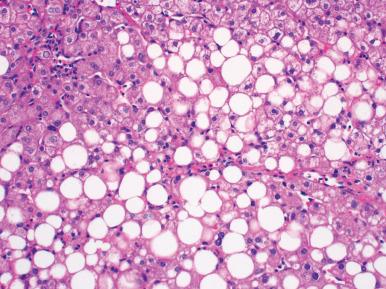
The pathologist should provide information on severity by indicating the approximate amount of parenchyma involved (mild: less than one-third; moderate: one-third to two-thirds; severe: more than two-thirds). Further useful information for the clinician is the finding of a mixed pattern of macro- and microvesicular steatosis because this may be of prognostic importance in relation to alcoholic liver disease. Of note, foci of steatosis may mimic metastatic liver disease radiographically.
Microvesicular steatosis ( Fig. 19.29 ) is often more difficult to recognize, and its demonstration may require histochemistry. Hepatocytes contain many tiny droplets of fat that may even be difficult to identify as such. It is generally a serious lesion associated with impairment of β-oxidation of lipids and frequently accompanied by disturbed liver function and coma. The causes are multiple. The first to be recognized, more than half a century ago, was AFLP (see later). Reye syndrome (see also earlier) occurs principally, but not exclusively, in young children; it presents clinically with an initial acute, mild viral illness, followed by vomiting, lethargy, and coma, resulting in death in about one-third of patients. The steatosis is usually panlobular, with smaller droplets in centrilobular areas and somewhat larger fat vacuoles in periportal regions. There may be necrosis of periportal hepatocytes. A number of Reye syndrome cases may be attributable to salicylate use. Many patients once thought to have Reye syndrome have been found subsequently to have defects in fatty acid oxidation, a form of primary mitochondrial hepatopathy . A number of inborn errors of mitochondrial fatty acid β-oxidation and inherited urea cycle disorders have been found to cause microvesicular steatosis. Conditions associated with microvesicular steatosis are potentially life threatening, with impairment of liver function and effects on other tissues as well. In the event that the patient survives, there are no long-term effects on the liver.
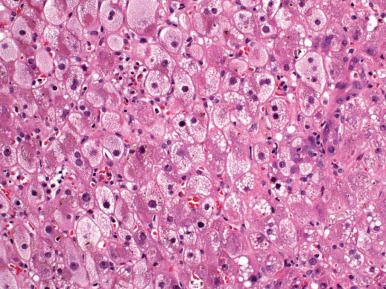
A number of therapeutic drugs have also been associated with the development of microvesicular steatosis (see earlier). Other causes include alcohol, fulminant hepatitis D in the Amazon basin, and multiple hornet stings.
Lipogranuloma (or fat granuloma) represents a focal response to rupture of lipid-laden hepatocytes. It contains macrophages, occasional lymphocytes, eosinophils, and sometimes giant cells ( Fig. 19.30 ), in addition to adipocytes. Serial sections may be required to identify a central fat globule and to differentiate the lesion from other forms of granuloma. They can be abundant, especially in fatty liver disease and hepatitis C. Lipogranulomas may lead to focal fibrosis without great clinical significance.
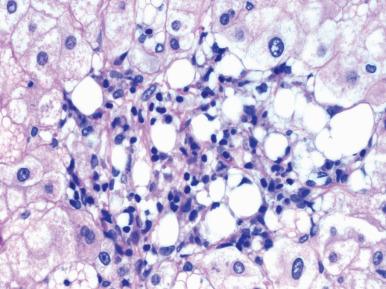
The understanding of hepatic steatosis has progressed considerably in recent years. Several studies have challenged previous assertions that macrovesicular steatosis is entirely benign, and indicate that fatty liver of either alcoholic or non-alcoholic etiologies can coincide with or lead to necroinflammation and fibrosis. The mere presence of oxidizable fat within the liver appears to be enough to trigger lipid peroxidation in animal studies. Nevertheless, many patients with steatosis never progress to necroinflammation or fibrosis. These observations have led to the “two-hit” hypothesis, which proposes that in addition to steatosis (the first “hit”), the development of steatohepatitis requires the presence of some other factor(s) (second “hit”). It is likely that multiple factors together result in accumulation of fat in the liver and cause tissue injury, including insulin resistance, oxidative stress, mitochondrial dysfunction, bacterial (+ endo) toxins, tumor necrosis factor alpha (TNF-α), interleukin (IL)-β, IL-6, low adiponectin levels, high leptin, high resistin, genetic predisposition, and of course factors that are still unknown.
The two most common types of steatohepatitis in the world, by far, are alcoholic steatohepatitis (ASH) and NASH. The pathogenesis and progression of hepatic disease appears to be driven by similar mechanisms in both conditions, although with superimposed toxicities of alcohol and its metabolite acetaldehyde in ASH, in part explaining why a greater proportion of patients with ASH develop cirrhosis and liver-related mortality.
In its early stages, ASH affects predominantly the centrilobular zone and includes a constellation of changes that need not all be present in any individual case. The most essential features are: (1) liver cell injury reflected in ballooning of hepatocytes with or without MDBs and liver cell death by necrosis and/or apoptosis ; (2) inflammatory infiltrates composed predominantly, though not exclusively, of neutrophils; and (3) pericellular fibrosis (so-called chicken-wire fibrosis), sometimes accompanied by perivenular fibrosis and phlebosclerosis. The severity of the changes and the extent of lobular involvement may vary considerably and do not necessarily correlate directly with clinical and biochemical data. There have been numerous reviews of the histopathology of ASH over the years, in which it has also been referred to as acute alcoholic hepatitis, acute hepatitis of the alcoholic type, alcoholic steatonecrosis, and fatty liver hepatitis.
Ballooning degeneration ( Fig. 19.31A and B ) is considered a hallmark of steatohepatitis, but enlarged hepatocytes may also be observed in a variety of other acute and chronic liver diseases. It has been reported that keratin 8/18 immunostaining is drastically reduced or lost in the cytoplasm of ballooned hepatocytes in alcoholic and NASH, chronic cholestatic conditions, ischemia/reperfusion injury, and in ballooned hepatocytes in chronic hepatitis C cases with concurrent steatohepatitis. In contrast, substantial decrease or loss of keratin 8/18 immunostaining is not noted in cases of acute hepatitis, giant cell hepatitis, chronic HBV, or autoimmune hepatitis. Therefore, keratin 8/18 immunostaining may serve as an objective marker of a specific type of ballooning degeneration of hepatocytes. Ballooned hepatocytes may contain so-called Mallory bodies (recently renamed “Mallory–Denk bodies”), which are homogeneous, eosinophilic, perinuclear inclusions of variable size and shape ( Fig. 19.31C ). MDBs are protein aggregates consisting of ubiquitinated K8/K18, chaperones, and sequestosome 1/p62 (p62) as their major constituents. The constant presence of p62 in MDBs suggests that binding of p62 to abnormal keratins may allow hepatocytes to dispose potentially harmful proteins in a biologically inert manner. Genetic contributions help explain why some patients develop MDBs, whereas others are less likely to do so. The pathobiology of these intriguing cell inclusions has been periodically reviewed. In florid cases, MDBs are easily discernible in routinely stained sections. In mild disease, they may be small and difficult to identify. Immunostaining of keratins or ubiquitin is helpful. Neutrophil granulocytes often surround and even invade hepatocytes containing MDBs (so-called satellitosis). Macrophages, and lymphocytes may also be found, and cholestasis is variably present.
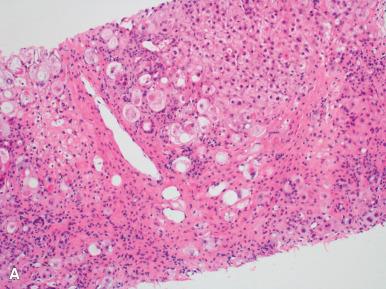
Steatosis is frequently a feature, although not always, and is usually macrovesicular. As mentioned, a mixed macro- and microvesicular pattern carries a worse prognosis ( Fig. 19.32 ). Still worse is an almost panlobular, predominantly microvesicular steatosis with canalicular bilirubinostasis (so-called alcoholic foamy degeneration). Megamitochondria appear as eosinophilic, PAS–diastase-negative, round, oval, or cigar-shaped inclusions of variable size. They can be better visualized with chromotrope–aniline blue (CAB) stain and immunohistochemistry. They are not specific for alcohol-induced liver disease, but several authors found them more frequently in liver with alcohol-related fibrosis. Oxyphilic granular hepatocytes or oncocytes are another common, though not pathognomonic, cellular component in acute and chronic alcoholic liver disease. Ultrastructurally, they are characterized by an extraordinary number of mitochondria (mitochondriosis).
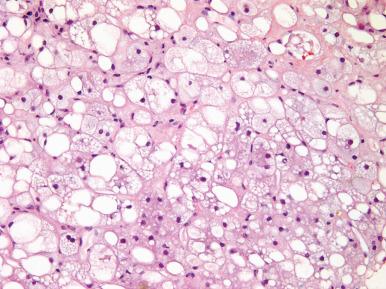
Fibrosis is a constant feature in ASH, although it appears in different patterns. The most characteristic is pericellular (or perisinusoidal) “chicken-wire” fibrosis, ensheathing hepatocytes ( Fig. 19.33A ). Its adequate identification usually requires collagen stains. Fibrosis may also involve the central vein, resulting in thickening of its wall (perivenular fibrosis). It has been suggested that this lesion is a marker of future cirrhosis, but others give more prognostic importance to pericellular fibrosis. When pericellular fibrosis is severe and associated with perivenular liver cell necrosis, this pattern is known as sclerosing hyaline necrosis ( Fig. 19.33B ), and the fibrosis may result in portal hypertension even in the absence of true nodular cirrhosis. In chronic alcoholic liver disease there may also be significant portal tract/septal fibrosis, and in later stages, necrotic bridges and fibrous septa start to link central veins with portal tracts, obscuring lobular topography, which together with parenchymal regeneration, lead to cirrhosis. A semiquantitative scoring system suitable for alcoholic fibrosis has been published.
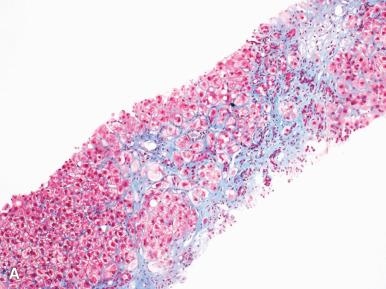
Cirrhosis of alcoholic origin is typically of the micronodular type ( Fig. 19.34 ). Ongoing superimposed lesions of steatohepatitis worsen the prognosis and suggest the etiology. In their absence, an alcoholic etiology can be suspected (but not proved) on account of the micronodular pattern, pericellular fibrosis, steatosis, and central vein occlusions. When the patient stops alcohol intake, parenchymal regeneration improves, nodules increase in size, and all features of alcoholic etiology may disappear. Patients with established alcoholic cirrhosis have a 5-year cumulative risk of developing hepatocellular carcinoma of approximately 8%.
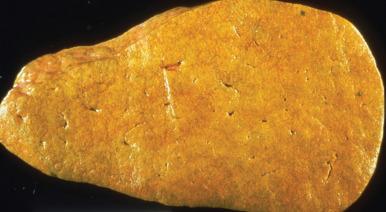
Several authors have drawn attention to other histologic features in the spectrum of alcoholic liver disease, including veno-occlusive lesions, portal tract inflammation and fibrosis, cholestasis, ductular reaction, and iron overload. Hepatocellular siderosis occurs in some alcoholics and may be confused with genetic hemochromatosis. Difficult cases may be solved by quantitative tissue iron determination and calculation of the hepatic iron index (HII). The morphology of alcoholic liver disease can also be significantly affected by abstinence; furthermore, the clinical and morphologic phenotype can be influenced by the presence of comorbid conditions such as NAFLD, viral hepatitis, or hemochromatosis.
Differential diagnosis of ASH . The primary entity in the differential diagnosis is NASH (see later), and this dilemma cannot be solved by histology alone because of the essentially identical histopathology. An incomplete picture of ASH, with only perivenular and pericellular centrilobular fibrosis, may be confused with chronic venous congestion. MDBs, neutrophils, and fibrosis can be seen in diseases unrelated to alcohol, such as amiodarone toxicity and Wilson disease; the latter is a differential diagnosis that should always be considered with alcoholic liver disease, especially in younger patients. MDBs and hepatocyte ballooning are occasionally seen in chronic cholestatic disease, but there is typically a periportal predominance of these changes (rather than a centrilobular distribution). Viral hepatitis is usually suspected clinically, and the liver histopathology is quite different from ASH. Hypervitaminosis A (see earlier) may cause pericellular fibrosis progressing to cirrhosis, and the pathologist should be alert for hepatic stellate cell hyperplasia.
Non-alcoholic liver disease in the alcoholic patient . Patients with a heavy alcohol intake may also suffer from a variety of non-alcoholic liver diseases, such as others cholangitis, viral hepatitis, and passive venous congestion. Alcohol intake may hasten the onset of hepatic and cutaneous manifestations of PCT . The hepatocytes contain birefringent acicular cytoplasmic inclusions and usually some degree of siderosis. Chronic alcohol ingestion may also increase the risk of acute DILI, such as acetaminophen-induced centrilobular necrosis. Alcoholic patients undergoing aversion therapy with cyanamide (see earlier) may develop a dramatic form of ground-glass change in periportal hepatocytes, which may lead to cirrhosis. Severe siderosis in the alcoholic patient may be the result of genuine genetic hemochromatosis, which can be confirmed by quantitative iron determination and genotyping. Chronic venous congestion resulting in centrilobular fibrosis can be seen in patients with alcoholic cardiomyopathy.
Chronic alcoholic pancreatitis may lead to stricturing of the common bile duct and cause lesions of extrahepatic bile duct obstruction with or without cholangitis, and some of these patients may develop biliary cirrhosis. An exclusively or predominantly periportal pattern of fibrosis in alcoholic patients should arouse suspicion for some other cause, particularly in the absence of other histologic features of alcoholic liver disease. It should also be remembered that alcoholic hepatitis often coexists with chronic HBV and/or HCV infection.
The known causes of NASH are numerous and include jejunoileal bypass surgery, gastroplasty, and other causes of rapid and profound weight loss in obese subjects; TPN; drugs (amiodarone, perhexiline maleate, estrogens and estrogen receptor ligands, methotrexate, retroviral therapy); occupational hepatotoxicity as reported from a petrochemical plant in Brazil ; vinyl chloride exposure ; copper toxicity; and disorders characterized by insulin resistance. In most cases, the etiopathogenesis of NASH appears multifactorial (obesity, type 2 diabetes, and hypertriglyceridemia) and can be regarded as the hepatic consequence of the metabolic syndrome (also known as cardiovascular dysmetabolic syndrome or syndrome X). The liver pathology was first recognized by H. Thaler in 1962 and later extensively described (including the histologic components of fatty change, lobular inflammation, and pericellular fibrosis) and termed NASH by Ludwig et al. This study also proposed a subclassification differentiating primary NASH (related to obesity and insulin resistance) from secondary NASH (post bypass surgery, drugs, and toxins). Very soon, however, the term NASH became reserved for the disease associated with the “metabolic syndrome” or “insulin resistance syndrome,” an aggregate of disorders related to obesity, insulin resistance, type 2 diabetes, hypertension, and hyperlipidemia, and related to the emerging epidemic of obesity in the West and in other parts of the world. It is estimated that in the United States, NAFLD affects about 20%–30% of adults and 10% of children.
Visceral fat accumulation is more important in the pathogenesis of the metabolic syndrome than general obesity. In human visceral obesity, white adipose tissue is enriched in macrophages. The presence of macrophages in omental white adipose tissue participates in the cellular mechanisms favoring hepatic fibroinflammatory lesions in obese patients. Mildly inflamed adipose tissue functions as an endocrine organ with the capacity to release protein signals, including the adipokines involved in energy and glucose metabolism: leptin, adiponectin, resistin, and visfatin. Visceral fat appears to be directly associated with liver inflammation and fibrosis by itself, independent of insulin resistance and hepatic steatosis. Pessayre and Fromenty suggested that NASH can be considered to some extent to be a mitochondrial disease, since mitochondrial dysfunction is involved at each successive step leading to NASH. Chemokines, cytokines, and innate immune processes, occurring both within and outside the liver, are also involved in insulin resistance and end-organ damage in the form of NAFLD.
The histologic criteria put forth by Ludwig et al. included patterns of injury that are similar to those of ASH. However, the minimal criteria for the diagnosis of NASH were originally controversial. The term NAFLD has been proposed as a more inclusive term that incorporates the various grades of severity in the entire spectrum of non-alcoholic steatotic syndromes. The topic was discussed in a review by Brunt, who observed that not all of the lesions of alcoholic liver disease are present in NASH, and conversely, that not all of the lesions of NASH are seen in alcoholic liver disease. Lesions in alcoholic liver disease that have not been seen in NASH include sclerosing hyaline necrosis, veno-occlusive lesions, ductular reaction and cholangiolitis, and acute cholestasis. Further discussion of criteria and terminology resulted in accepted criteria for both mild and more severe NAFLD. The presence of steatosis alone has been considered a rather mild alteration (simple steatosis or non-alcoholic fatty liver [NAFL]); this concept, on second thought, might deserve reconsideration (see also earlier). The condition is less benign when steatosis is associated with portal and/or lobular inflammation and fibrosis, known as NAFLD ( Fig. 19.35A and B ). The addition of hepatocellular ballooning and Mallory–Denk inclusions results in NASH ; at this point the disease becomes potentially more serious and progressive, even resulting in cirrhosis and/or hepatocellular carcinoma ( Fig. 19.36 ). There appears to be a relationship between the severity and zonal location of steatosis and the presence of the histologic features of NASH; that is, as compared to centrilobular steatosis, panlobular steatosis is more often associated with ballooning, MDBs, and advanced fibrosis.
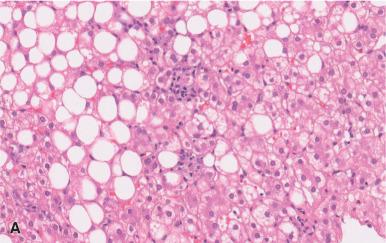
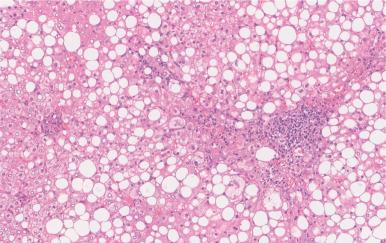
As in alcoholic liver disease, MDBs can be better visualized by ubiquitin and p62 immunostaining.
Further alterations include microvesicular steatosis, glycogenated nuclei, megamitochondria, and glycogen-rich hepatocytes ; the latter resembles the hepatocellular changes described in diabetes-associated glycogenic hepatopathy and must be differentiated from hepatocellular ballooning. It is important to realize that no qualitative histologic differences exist between ASH and NASH that would allow classification of any individual case as alcoholic or non-alcoholic in etiology, on the basis of morphology alone. However, when larger groups of patients are compared, NASH is usually associated with more fat and nuclear glycogen, but less hepatocellular damage, inflammation, and fibrosis, and fewer MDBs than ASH. However, progression to cirrhosis is definitely possible in patients with NASH. Ethnicity also influences metabolic derangements, as well as histology, in NAFLD. One study found that African Americans showed a lower degree of steatosis than whites, but that, in contrast, Asians and Hispanics showed more ballooning and MDBs, respectively, than whites and other ethnicities combined, thus highlighting the need for prospective studies to evaluate ethnic differences in NAFLD.
The diagnosis of NASH is not dependent on a single histopathologic feature but involves assessment of multiple elements. A semiquantitative scoring system for grading and staging the histologic lesions in NASH has been published by Brunt et al. The Pathology Committee of the NASH Clinical Research Network designed and validated a histologic scoring system that addresses the full spectrum of lesions of NAFLD and proposed a NAFLD activity score (NAS) for use in clinical trials. The proposed NAS is the unweighted sum of steatosis, lobular inflammation, and hepatocellular ballooning scores. This represents a scoring system and activity index for NAFLD and NASH with reasonable interrater reproducibility that should be useful for studies of both adults and children with any degree of NAFLD. A value of NAS of ≥5 correlates with a diagnosis of NASH. Note that this system is intended for use in clinical trials and not as a tool for diagnosing NASH in routine clinical practice. It always has to be kept in mind that parenchymal injury and fibrosis may vary in different regions of the liver, thus creating the possibility of sampling variability in needle biopsy specimens.
Brunt et al. noted that significant portal mononuclear inflammation is associated with many clinical and pathologic features of progressive NAFLD in both adults and children, and that such infiltrate in liver biopsies of untreated NAFLD may be considered a marker of advanced disease. However, significant portal inflammation may also be a sign of co-existent disease, such as hepatitis C or autoimmune hepatitis.
Portal fibrosis in the absence of other features of NASH, termed isolated portal fibrosis (IPF), has received less attention and has not been classified as a feature of NAFLD. Nevertheless, a significant subset of morbidly obese individuals has portal fibrosis in the absence of features of NASH associated with glycemic dysregulation. It resembles the pattern of NAFLD in the majority of affected children (see later). Therefore, IPF could be considered a part of the spectrum of NAFLD that may precede NASH in morbid obesity.
Periportal and septal fibrosis is a key feature of progressive disease in NASH. Fatty liver impairs hepatocellular regeneration, which triggers a reserve replicative pathway using the bipotential, periportal, hepatic progenitor cells. Activation of this pathway by cell injury in NASH induces a periportal ductular reaction that plays a promoting role in periportal fibrogenesis. When cirrhosis develops, the other histologic features of NASH activity may persist or disappear. In the latter instance, the underlying diagnosis of NASH is often no longer recognizable, and the case falls in the category of cryptogenic cirrhosis. How often this occurs has not been established, but it has been suggested on reasonable grounds that many cases of cryptogenic cirrhosis derive from NASH. When appropriate criteria are used, NAFLD appears to account for close to two-thirds of cases currently labeled as cryptogenic cirrhosis; however, it would be erroneous to assume that all cryptogenic cirrhoses derive from NASH, since cirrhoses from various other etiologies may “burn out” as well. Recurrent fatty liver disease is common following liver transplantation for NASH cirrhosis but does not typically lead to early allograft failure.
Recurrent NASH can occur despite normal liver enzymes, and features of metabolic syndrome are associated with disease recurrence. NASH-related cirrhosis carries a substantial risk for early HCC development. Given the epidemic of obesity and diabetes, the incidence of NASH-related HCC is expected to increase (see also Chapter 20 ).
Histologic evaluation was fundamental to the initial studies that introduced and defined the concept of fatty liver disease, and liver biopsy remains essential in the diagnosis and evaluation of NAFLD and NASH. Currently, liver biopsy in NAFLD serves multiple roles: confirmation (or exclusion) of the diagnosis; distinction of steatohepatitis from “simple steatosis”; assessment of extent of necroinflammatory activity, fibrosis, and architectural alterations ; and excluding other causes of liver disease, such as viral hepatitis. The histologic severity of liver injury and inflammation is strongly associated with an increased cardiovascular risk and an atherogenic lipid profile. With early biopsy, and early intervention, the ability to prevent advanced liver disease was found to be high, and biopsy may be indicated even in patients with normal alanine transaminase who are suspected to have NAFLD. In view of the huge numbers of patients involved, and the risk, cost, and limitations of liver biopsy, intensive efforts are underway for establishing valuable noninvasive methods for diagnosis in this context.
Given the current worldwide epidemic of pediatric obesity, NAFLD is increasingly diagnosed in children, and NAFLD is now the most common cause of chronic liver disease in children. The rising incidence in children is not restricted to Western populations; epidemiologically, there is a male predominance and frequent Asian and Hispanic ethnicity. It is not exactly identical to NAFLD in adults, perhaps in part because the metabolic derangements of the disease occur during periods of active growth (infancy, mid-childhood, and puberty). The histopathology of pediatric NAFLD and NASH is also reported to be somewhat different from that in adults. Studies noted a minority of what was termed type 1 (similar to classic or adult NAFLD), and predominance of type 2, characterized by more severe steatosis, little or no ballooning degeneration, less lobular inflammation, few or no polymorphonuclear leukocytes, more portal tract inflammation, less zone 3 chicken-wire fibrosis, and more periportal fibrosis, thus making childhood NASH look a bit more like a “chronic hepatitis.” However, a recent multicenter study reported that in the vast majority of the studied patients, overlapping features of both type 1 adult NASH and type 2 pediatric NASH were found and that although portal-based injury is frequently found in children, it is almost universally associated with some elements of the centrilobular pattern identified in adults. Liver biopsy is also required for an adequate evaluation of the severity and pattern of pediatric NAFLD and NASH in children.
It is important to note that the coexistence of NASH and chronic viral hepatitis C causes a mutual synergistic effect in fibrosis progression and evolution to cirrhosis, as discussed earlier. This association may also affect the response to antiviral therapy; patients chronically infected with HCV genotypes 2 and 3, and with insulin resistance, were six times more likely to achieve sustained viral response if their insulin resistance was mild (Homeostasis Model Assessment of Insulin Resistance [HOMA-IR] <2) than those with more severe insulin resistance (HOMA-IR >2).
It has been suggested that, given that NASH is a negative term ( non -alcoholic) for a condition that is caused by many different etiologies (viruses, metabolic syndrome and/or obesity, drugs, rapid weight loss, inherited metabolic disease), that a positive nomenclature would be more informative. Some have advocated discarding the acronym NASH, and making diagnoses according to etiology, such as viral-associated steatohepatitis (VASH, e.g., in HCV genotype 3), drug-associated steatohepatitis (DASH), alcohol-associated steatohepatitis (AASH), metabolic-associated steatohepatitis (MASH), and perhaps—why not?—CASH (cryptogenic-associated steatohepatitis). But nomenclature is tough to change!
Fatty liver disease may also act synergistically with other chronic liver diseases to aggravate parenchymal injury. There is evidence that steatosis and its metabolic abnormalities also exacerbate alcoholic liver disease, hemochromatosis, and, possibly, drug-induced liver disease.
As discussed previously, a major cause of hepatomegaly in patients with diabetes is steatosis. In both adults and children with type 1 diabetes mellitus, hepatomegaly and abnormalities of liver enzymes also occur as a consequence of hepatocellular glycogen accumulation. This is believed to be a function of the body habitus and state of insulin resistance rather than glycemic control. The livers of affected patients are characterized by marked glycogenosis, a pathologic overloading of hepatocytes with glycogen, known as glycogenic or diabetic hepatopathy . Liver biopsy shows diffusely pale staining hepatocytes on H&E stains ( Fig. 19.37 ), with excessive glycogen accumulation demonstrated by PAS stains. Ultrastructural examination reveals marked glycogen accumulation in the cytoplasm and nuclei. If accompanied by cushingoid features, growth retardation, and delayed puberty, a diagnosis of Mauriac syndrome can be made. The distinction between steatosis and glycogenosis is important: whereas steatosis may progress to fibrosis and cirrhosis, glycogenosis does not, but reflects the need for better diabetic control. Glycogenosis and steatosis cannot be distinguished reliably on ultrasound examination; the histology, however, is definitive. Patients undergoing dietary management of urea cycle defects with diets containing essential amino acids may have similar focalor diffuse glycogen accumulation in hepatocytes which—exceptfor the focality in deposition—resembles that in glycogen storage disease. Glycogenosis was also described in a patient withanorexia nervosa where it was interpreted as an adaptive response to starvation.
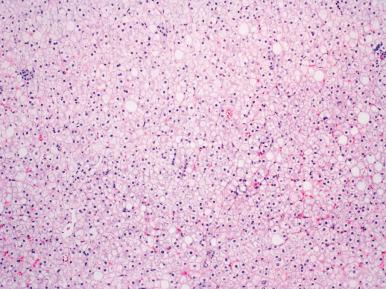
Sinusoidal lesions may also be part of the changes seen in the liver in diabetes. Marked sinusoidal fibrosis has been reported secondary to longstanding diabetes mellitus, in the absence of NASH. The patients have evidence of microvascular complications, including retinopathy, nephropathy, and peripheral and autonomic neuropathy. Liver biopsy shows extensive dense perisinusoidal fibrosis, and immunostaining reveals basement membrane components in a perisinusoidal distribution. The term diabetic hepatosclerosis (DHS) has been suggested for this entity, indicating a form of diabetic microangiopathy affecting the liver. Electron microscopy of sinusoids and sinusoidal cells reveals numerous thick collagen bundles in the space of Disse, and increased basement membrane–like material underlying the sinusoidal cell population. Perisinusoidal cells appear active with abundant rough endoplasmic reticulum and thick cellular processes. The prevalence of DHS was 12% in an autopsy series, suggesting that it is not uncommon, but in the majority of patients it was clinically silent ; another more restricted study of autopsied diabetic patients revealed DHS in only one case out of 57, associated with nodular glomerulosclerosis and hepatic hyaline arteriolosclerosis.
The histologic changes in the liver in cholestatic liver diseases can be conceptualized in two ways: (1) features of cholestatic liver diseases in general; and (2) features characteristic of individual cholestatic liver diseases. The former allows the diagnostic histopathologist to distinguish between cholestatic and noncholestatic disorders, whereas the latter serves to differentiate between diseases within the group of cholestatic disorders.
The term cholestasis refers to an arrest, or at least a marked reduction, in bile secretion and bile flow. It may be caused by a functional secretory disturbance of the hepatic parenchymal cells, and/or by obstruction at any level in the excretory pathways of bile, from the canaliculi to the papilla of Vater. Intrahepatic cholestasis refers to those conditions in which the primary lesions are located inside the liver itself; this term thus encompasses diseases of the parenchymal cells and of the intrahepatic bile ducts. Some conditions combine both; for instance, progressive familial intrahepatic cholestasis (PFIC) type 3 involves both a deficit of canalicular phospholipid transport and damage to interlobular ducts. Extrahepatic cholestasis occurs when the bile excretory block is located in larger ducts: outside the liver along the extrahepatic bile ducts (e.g., gallstones, bile duct tumors, bile duct strictures) but also in larger hilar intrahepatic ducts. Some cholestatic disorders affect both the intra- and extrahepatic segments of the biliary tree, and hence qualify as combined intra- and extrahepatic cholestatic diseases. Examples are neonatal extrahepatic bile duct atresia and PSC.
The block in bile secretion may be complete or variably incomplete. Complete cholestasis denotes a total arrest of bile secretion, with retention of bile salts and bilirubin, be it functional or obstructive. Incomplete cholestasis usually indicates an incomplete or partial obstruction of the intrahepatic and/or extrahepatic bile ducts, with retention of bile salts but not of bilirubin.
Incomplete intrahepatic cholestasis is mostly due to destructive diseases of intrahepatic bile ducts such as PBC and PSC. Incomplete extrahepatic cholestasis corresponds to incomplete obstruction (narrowing or strictures) of segments of larger bile ducts.
Cholestasis may be acute or chronic. Acute cholestasis is usually complete cholestasis, corresponding to either total functional exocrine secretory failure of the hepatocytes (e.g., drug-induced cholestasis), or complete obstruction of the extrahepatic bile ducts (e.g., impacted gallstone). Chronic cholestasis indicates a cholestatic condition of longer duration (weeks, months, years), which may be complete (e.g., chronic total extrahepatic bile duct obstruction by a carcinoma of the pancreas) or variably incomplete (e.g., PBC, PSC).
Cholestasis and icterus (or jaundice) are not synonymous terms: the distinction must be made between icteric and anicteric conditions of cholestasis. Patients with incomplete cholestasis may remain anicteric for long periods. In parallel, histologic cholestasis is not necessarily characterized by the microscopically visible accumulation of the bile pigment bilirubin in liver tissue sections. This underscores the usefulness of distinguishing between bilirubinostasis (which many pathologists do, in fact, use interchangeably with the term cholestasis) and cholate stasis , or accumulation of bile salts with accompanying characteristic histologic changes. These features may be seen in cholestatic liver diseases either separately or in combination. A comprehensive overview of the pathology of cholestasis was published by Li and Crawford.
Acute complete cholestasis . An acute cholestatic liver disease associated with complete cholestasis is characterized by microscopically demonstrable bilirubin accumulation ( Fig. 19.38 ) which starts in the centrilobular zone; it features pigment granules in parenchymal cells (hepatocellular bilirubinostasis) and inspissated bilirubin-stained bile plugs in dilated intercellular canaliculi (canalicular bilirubinostasis). Retention of detergent bile acids results in hepatocellular damage and even death (necrotic or apoptotic), leading to Kupffer cell activation. The hypertrophic Kupffer cells phagocytose the debris from dying parenchymal cells and the liberated canalicular bile plugs, resulting in Kupffer cell bilirubinostasis. The latter feature indicates a cholestatic condition of at least several days' duration. Acute complete cholestasis, especially in cases of extrahepatic obstructive origin, is further characterized by edema of the portal tract connective tissue, causing some rounding of portal contours, and an incipient ductular reaction (described later).
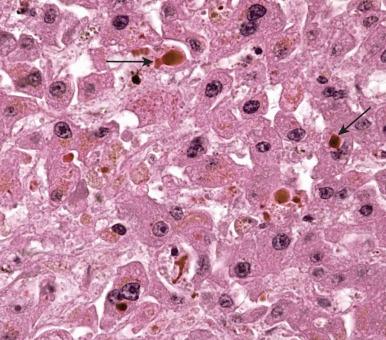
Bilirubinostasis in its various locations should not be confused with lipofuscin (see earlier), or with the dark brown to black deposits (in hepatocytes, canaliculi, Kupffer cells, and ductules) in liver biopsies from patients with erythropoietic protoporphyria. The latter deposits are darker brown or black and easily identified by the use of polarized light; protoporphyrin deposits have a red to yellow birefringence with a Maltese cross configuration in coarser (ductular) deposits ( Fig. 19.39A and B ).
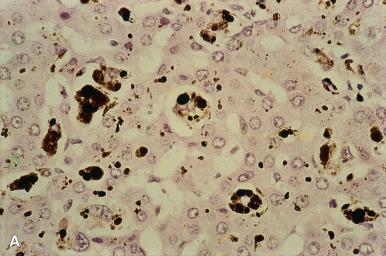
Chronic complete cholestasis . The parenchymal changes in complete cholestasis of longer duration include a number of lesions appearing over time and superimposed on the early bilirubinostasis, which gradually extends toward the periportal parenchyma. In most forms of chronic cholestasis lasting for weeks, some lymphocytic inflammatory infiltrate occurs in the areas with bilirubinostasis, apparently secondary to cholestatic changes. Unlike the inflammation in acute hepatitis, this infiltrate is mild and restricted to the area with bilirubinostasis. The parenchymal, portal, and periportal alterations observed in chronic complete cholestasis also occur in chronic incomplete cholestasis, as described in the following section. The basic difference between chronic complete cholestasis and the incomplete variety consists in the absence of bilirubinostasis in the incomplete category and the occasionally more pronounced expression of some of the other lesions in the complete variety.
Chronic incomplete cholestasis . As mentioned previously, bilirubinostasis (as well as clinical jaundice) is not a feature of liver diseases associated with incomplete cholestasis, except in the terminal decompensating phase of the disease or in the case of superimposed pathologic changes (e.g., drug-induced liver damage). Thus, the histopathologist may be required to identify the presence of a chronic cholestatic liver disease in the absence of what used is often regarded as a characteristic feature of cholestasis (bilirubinostasis). The histopathologic diagnosis of chronic (complete as well as incomplete) cholestasis relies on several parenchymal, portal, and periportal alterations. The parenchymal changes include cholate stasis, cholestatic liver cell rosettes, feathery degeneration, xanthomatous cells, and bile infarcts. These alterations occur despite the activation of a series of defense mechanisms on behalf of the parenchymal cells, including repression of bile acid synthesis and induction of basolateral bile acid export by the alternative bile acid efflux pump MRP4 as adaptive mechanisms to limit the bile acid burden in chronic cholestasis. These mechanisms, however, do not sufficiently counteract cholestatic liver damage.
Cholate stasis is thought to be due to the membrane-damaging effect of retained bile acids, and primarily affects periportal hepatocytes. The affected hepatocytes appear swollen, pale, and coarsely granular ( Fig. 19.40 ); they contain granules of lysosomal copper, complexed with copper-binding protein (metallothionein), which are stainable with orcein (metallothionein) and rhodanine (copper) stains ( Fig. 19.41A and B ). With time, MDBs develop in these cells, and bilirubin inclusions also may appear in the very late stages. The earliest stages of cholate stasis may be revealed by immunostaining for keratin 7, revealing a phenotypic switch to a biliary type of intermediate filament cytoskeleton in periportal hepatocytes ( Fig. 19.42 ). With time, keratin 7 expression extends with a decreasing gradient from the limiting plate toward the center of the lobule, over a distance of several cells.
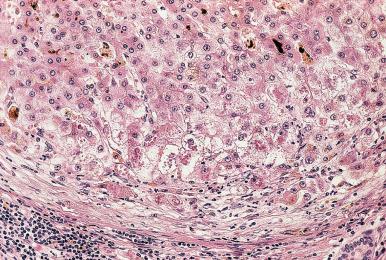
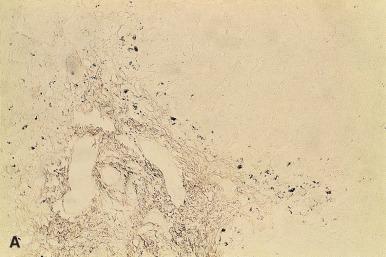
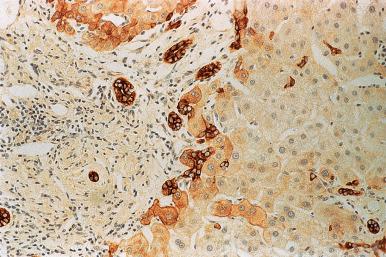
Cholestatic liver cell rosettes represent a very useful diagnostic feature in any chronic cholestatic condition. They correspond to a tubular rearrangement of the liver cell plates that are normally one cell thick. Under the light microscope, they appear as glandular or tubular structures lined by four or more hepatocytes around a central lumen ( Fig. 19.43A and B ). The lumen may vary greatly in diameter; it may appear empty, or filled with eosinophilic or bilirubin-stained material in variable degrees of inspissation. Some or all of the lining hepatocytes may show feathery degeneration (see later) and express bile duct–type keratins (keratin 7 and tissue polypeptide antigen [TPA]), indicating a partial shift toward a bile duct cell phenotype. This should not be misinterpreted as expression of hepatocellular regeneration.
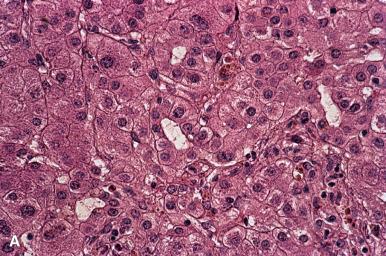
Feathery degeneration is another lesion observed in chronic (incomplete and complete) cholestasis. It affects single cells or groups of parenchymal cells characterized by hydropic swelling. There may be some bilirubin impregnation of the remaining visible cytoplasm in cases of chronic complete cholestasis. Xanthomatous cells are a feature of longstanding incomplete and complete cholestasis as well. They are lipid-laden histiocytes with foamy cytoplasm, accumulating in the parenchyma but also in portal tracts, appearing singly or in clusters. They are believed to represent the expression of the hyperlipidemia that accompanies chronic cholestasis.
So-called Charcot–Gombault infarcts are a late parenchymal lesion in severe cholestasis of long duration, mainly (but not exclusively) seen in large duct obstruction. The lesions consist of necrotic hepatocytes, mostly in a periportal location, sometimes showing bilirubin impregnation of the central necrotic area. Bile infarcts are gradually replaced by organizing mesenchymal tissue, finally resulting in fibrous scars.
Ductular reaction is recognized as an increased number of ductular profiles at the periphery of the portal tract, gradually extending into the periportal parenchyma toward the neighboring portal tracts, and often accompanied by edema and neutrophils ( Fig. 19.44 ). It can be visualized to better extent by keratin 7 or 19 immunostaining. The origin of the increased number of ductules is debated; it is apparently multiple. Ductular reaction in diseases with extrahepatic bile duct obstruction is mainly due to increased bile pressure, and involves elongation rather than sprouting of preexisting bile ductules. In other cholestatic diseases, not necessarily obstructive in origin, proinflammatory cytokines may be the predominant triggers. In chronic cholestatic diseases, ductular metaplasia of periportal hepatocytes also plays a role, as does activation and proliferation of hepatic progenitor cells. The cholangiocytes lining the ductules may show signs of reabsorption, reflected in vacuolization of their cytoplasm and accumulation of bilirubin and lipofuscin. The wedge-shaped periportal extension of ductular reaction with accompanying inflammation into the periportal parenchyma, which may show features of cholate stasis, results in an irregular portal–parenchymal interface, termed “biliary piecemeal necrosis” or biliary interface activity. For reasons that have not been finally elucidated, chronic states of cholestasis in some patients lack an obvious ductular reaction; this may be the case in Alagille syndrome (AGS), some cases of PSC, and chronic liver allograft rejection.
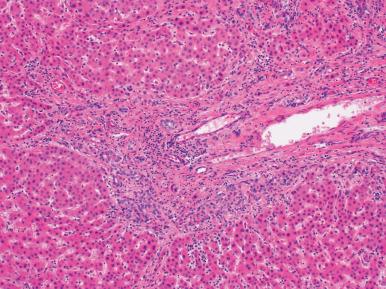
Ductular reaction may be accompanied by periductular fibrosis, with a significant correlation between the progression rates of fibrosis and of the ductular reaction. The fibrosis is produced by myofibroblasts that derive from portal/periportal mesenchymal cells. However, several recent studies equally emphasize contributions from cholangiocyte–mesenchymal transition. Relief of bile duct obstruction or cessation of the cause of cholestasis results in the disappearance of bile duct hyperplasia by apoptosis of cholangiocytes accompanied by a similarly rapid loss of the mesenchymal cells. Ductular reaction may be the only histologic change in some biopsies (termed isolated ductular hyperplasia). This has been found in 10% of adults biopsied for persistent mild liver function test abnormalities unrelated to viral hepatitis. The picture consists of well-differentiated hyperplastic ductules in the absence of significant inflammation. It is thought to represent a nonspecific reaction pattern to mild liver damage.
When progressive, ductular reaction with periductular fibrosis eventually results in fibrous linkage of adjacent portal tracts. This stage of biliary fibrosis (portal–portal septal fibrosis) is a potentially reversible lesion since the basic angioarchitectural pattern of the liver is preserved. Biliary fibrosis may progress to true biliary cirrhosis , which represents the final stage in disturbance of the lobular architecture, characterized—like any cirrhosis—by additional portal–central fibrous septa and nodular parenchymal regeneration. Persistent disease at the point of biliary cirrhosis is characterized by persistence of ductular reaction with accompanying edema and periductular inflammation and fibrosis. Together with lesions of cholate stasis in the nodular periphery, this creates at low magnification the impression of a clear “halo” between the cirrhotic nodules and the fibrous septa. Several staging schemes exist for chronic biliary disease, based on histologic features including interlobular bile duct damage, ductular reaction, and progressive biliary fibrosis. Historically, the stages have been defined as portal (stage 1), periportal (stage 2), septal (stage 3), and cirrhotic (stage 4). New staging systems have been proposed more recently, which take inflammatory activity into consideration as well as fibrosis and other features of chronic cholestasis.
In addition to the general features of cholestasis discussed previously, two other changes that often characterize the histologic picture in neonatal cholestatic liver diseases should be mentioned. Multinucleated giant cells result from syncytial fusion of several mononucleated hepatocytes. The number of nuclei and their location are variable. Giant cells often contain pigment granules corresponding to bilirubin, lipofuscin, hemosiderin, or a combination thereof. They may appear necrotic and be surrounded by neutrophils. Giant cell transformation of parenchymal cells occurs in a variety of conditions; they are considered a nonspecific reaction of the infant's hepatocytes to various types of injury and appear to be more specific for age than disease. They are occasionally observed in adult liver as well. Foci of extramedullary hematopoiesis , consisting of clusters of erythrocyte precursor cells, myeloid precursor cells, and megakaryocytes, or a combination of these, are often observed in cholestatic liver specimens of young infants as well. They are not a reliable criterion for differentiation between various cholestatic diseases such as BA and neonatal hepatitis.
Individual cholestatic liver diseases . Cholestatic liver diseases can be subdivided in several different ways: intrahepatic versus extrahepatic; medical versus surgical; neonatal versus adult, etc. In the following section, an attempt is made to classify the disorders according to the primary focus of the disease along the pathways through which bile has to travel from its source in the hepatocytes to its destination in the gut.
It is realized that such a categorization is imperfect: first, because the etiology and pathogenesis of several major cholestatic liver diseases remain incompletely clarified; and second, because some disorders involve two or more sites simultaneously.
Hepatocellular (parenchymal) diseases . For this group of disorders, it is useful to consider the serum levels and hepatic expression of the enzyme γ-GT. In most cholestatic conditions, serum γ-GT is increased. This is due to the fact that γ-GT, an enzyme normally inserted in the canalicular membrane of hepatocytes, is eluted from this membrane by the detergent action of bile salts after their export in the canaliculi, explaining the presence of γ-GT in bile. In cholestasis, bile (along with γ-GT) regurgitates through the canalicular tight junctions that have become leaky in these conditions. Thus, increased serum levels of γ-GT in cholestatic liver disease requires the presence of canalicular expression of γ-GT, its elution by bile salts, and regurgitation through leaky tight junctions.
Some cholestatic diseases, however, are characterized by a normal serum level of γ-GT or a serum activity of the enzyme that is unusually low for the degree of cholestasis (“low γ-GT cholestasis”). Cholestasis with (near-) normal serum γ-GT occurs in these circumstances :
When γ-GT cannot insert in the membrane due to inadequate phospholipid asymmetry in the membrane caused by ATP8B1 (previously FIC-1 ) mutation, and hence cannot be eluted from the membrane (e.g., progressive familial intrahepatic cholestasis [PFIC] type 1; benign recurrent intrahepatic cholestasis [BRIC] type 1).
When the bile salt export pump (BSEP) is absent from the membrane, due to BSEP mutation, and hence no bile salts are secreted (e.g., PFIC type 2; BRIC type 2).
When no appropriate normal bile salts are synthesized, and hence no bile salt secretion occurs through canalicular membranes (metabolic disorders of bile salt synthesis defects).
These primarily pediatric disorders are discussed in detail later. Several acquired cholestatic disorders are also characterized by predominantly parenchymal/hepatocellular features, including intrahepatic cholestasis of pregnancy (ICP; see later) and some forms of postoperative cholestasis, as well as acute viral hepatitis, ASH, and drug-induced liver disease (see earlier).
Ductular pathology . In some cholestatic disorders, the disease appears to focus on the ductules and canals of Hering. Most of these conditions are characterized by ductular reaction and ductular bilirubinostasis; the latter is represented by smaller or larger bilirubin-impregnated deposits or concrements in more or less dilated ductular segments ( Fig. 19.45 ). Ductular bilirubinostasis occurs in diverse situations and is thought to result from damage to ductular cells with total paralysis or partial impairment of their normal secretion of bicarbonate-rich fluid. Ductular bilirubinostasis is observed in patients with massive liver cell necrosis ; in septicemia and endotoxic shock (see also later) ; in extrahepatic BA ; in TPN ; and in some patients with mucoviscidosis (cystic fibrosis [CF]). In extrahepatic bile duct atresia, the ductular bilirubin deposits often appear as a string of pearls in a series of ductular dilations. TPN-associated liver injury is discussed in detail earlier; CF and extrahepatic BA are discussed later with pediatric liver diseases.
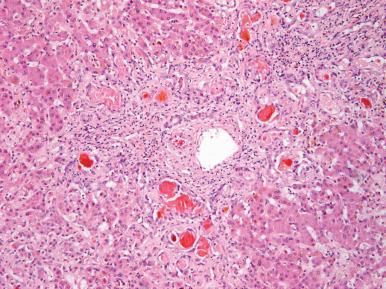
Ductal pathology and vanishing bile duct diseases . A number of cholestatic liver diseases are associated with progressive inflammatory destruction of intrahepatic bile ducts of a particular caliber. These may be classified as ductopenic or vanishing bile duct disorders and represent a vast and intriguing chapter in liver pathology ( Box 19.1 ). They all result in reduction of the number of interlobular bile ducts, also termed paucity of ducts or ductopenia. Vanishing bile duct diseases in the neonatal period and childhood include paucity of interlobular bile ducts (PILBD), both syndromic and nonsyndromic, and/or BA, which are discussed in detail in the section on pediatric liver disease.
Extrahepatic bile duct atresia or BA
Paucity of interlobular bile ducts
Syndromic (AGS)
Nonsyndromic
PBC
Overlap syndrome autoimmune hepatitis—PBC
PSC and variants
Overlap syndrome autoimmune hepatitis—PSC
Sarcoidosis with intrahepatic cholestasis
Idiopathic adulthood ductopenia
Chronic liver allograft rejection
Chronic graft-versus-host disease
Drug-induced ductopenia
Histiocytosis X
Hodgkin lymphoma
Mucoviscidosis
AGS , Alagille syndrome; BA , biliary atresia; PBC , primary biliary cirrhosis; PSC , primary sclerosing cholangitis.
A sound morphologic diagnosis of ductopenia requires a sufficiently large biopsy specimen to allow quantitative evaluation of interlobular ducts. Although historically a surgical biopsy was recommended, a needle biopsy may certainly suffice provided that the specimen contains at least five portal tracts. Recognition of a missing duct is facilitated by comparing with branches of the hepatic artery. As 70%–80% of arterial branches are normally accompanied by a duct of approximately similar size near the center of the portal tract, a “widowed” or unpaired artery signals a missing duct. Immunostains for keratin 7 (or 19) or TPA are helpful for better visualization of interlobular ducts, especially in very young children.
Paucity of interlobular ducts (or ductopenia) was originally defined as a ratio of the number of interlobular ducts to the number of portal tracts of less than 0.5. In normal children and adults this ratio lies between 0.9 and 1.8. This definition of ductopenia as a ratio of 0.5 or less was valid at the time of its definition in neonatal disease, but since 1975 evidence has accumulated that ductopenia in general is not a static condition but reflects a progressive destruction of interlobular ducts. It follows that a reduced bile duct to portal tract ratio higher than 0.5 (i.e., a less pronounced degree of ductopenia) can still be considered “ductopenia,” especially when damaged or inflamed ducts are also observed.
The histopathology in ductopenic diseases is mainly that of chronic incomplete cholestasis, with variably present features specific for an individual disease. One has to keep in mind, however, that such features are not consistently present in every biopsy specimen and may not persist throughout the entire course of the disease; in addition, the specificity of the histopathology may decrease with advancing disease and progression toward cirrhosis.
PBC is considered an autoimmune disease, often associated with other autoimmune disorders. The pathogenesis is complex, involving genetic predisposition as well as environmental factors, which remain incompletely understood. The basic lesion is a chronic, nonsuppurative, destructive cholangitis, eventually ending in cirrhosis. The disease is nearly 10 times more frequent in females than in males and usually has an insidious onset starting with pruritus. Characteristic of PBC is the presence of antimitochondrial antibodies (AMAs), the most specific being directed against the M2 component of the pyruvate dehydrogenase complex, detectable in over 90% of patients. Liver biopsy plays an important role in the diagnosis and staging of PBC.
The bile duct lesion in the early stage of PBC initially affects ducts ranging from less than 40 to more than 80 µm in external diameter, destroying the smaller ducts first. Septal ducts are affected to a lesser degree. Canals of Hering are also destroyed in PBC in concert with the destruction of small bile ducts; this destruction appears to be an early event. The actual size of the ducts may on occasion be difficult to estimate since some of them tend to enlarge, apparently through damage to the basement membrane and reactive hyperplasia of the lining epithelium. The early lesions are focal in the liver and segmental within the duct system. The affected duct segments show epithelial swelling and cytoplasmic vacuolization, nuclear disarray, and infiltration by lymphocytes and plasma cells, which may accumulate beside or around the duct. The inflammatory infiltrate is predominantly lymphocytic and sometimes forms lymphoid follicles with a germinal center. Plasma cells may be abundant, eosinophils quite prominent, and neutrophils may also be present ( Fig. 19.46 ). Plasma cells in the portal tracts are predominantly IgM+, whereas in autoimmune hepatitis, plasma cells are predominately IgG+; therefore, immunostaining for IgM and IgG can be helpful in differentiating PBC from AIH. An Italian study reported that the mean counts of IgM plasma cells in portal tracts correlated significantly with female gender; serum alkaline phosphatase, γ-GT and IgM values; positivity for AMA M2, and, on liver biopsy, with bile duct changes, orcein-positive granules, and granulomas. In contrast, IgG plasma cell mean counts correlated more with alanine aminotransferase levels. IgG/IgM ratios lower than 1 were found not only in PBC but also in all cases of autoimmune cholangitis. In contrast, all patients with overlap syndrome showed IgG/IgM ratios higher than 1.
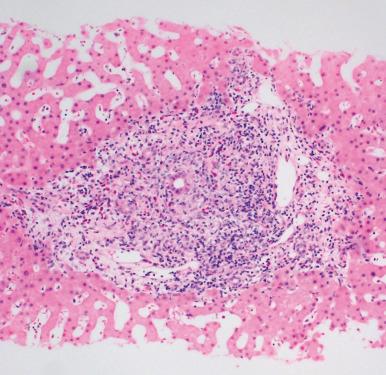
Single or small clusters of epithelioid cells may be present, and in some cases epithelioid granulomas develop close to or surrounding the bile duct. The florid bile duct lesion in PBC can thus be categorized as lymphocytic, pleomorphic, or granulomatous cholangitis ( Fig. 19.47 ), the latter being the most diagnostic. Smaller ducts may be surrounded by edema or fibrosis, presumably as a result of more distal obstruction, and damage of the basement membrane (often most visible with PAS/diastase stain) may lead to rupture of the duct. Parenchymal lesions of chronic cholestasis are absent or minimal at the early stage.
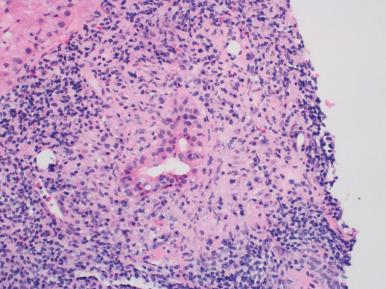
Sampling variability means that not every liver biopsy from a patient with PBC in this stage reveals the characteristic bile duct lesions, making a firm histologic diagnosis challenging. The presence of periportal copper deposition may be extremely helpful.
The majority of patients show histologic progression within 2 years; a minority (20%) remain histologically stable, whereas sustained regression is rare (2%). Basically, two processes appear to drive histologic progression: the periportal and architectural changes associated with chronic cholestasis (see earlier), and lymphocytic interface hepatitis (piecemeal necrosis). As in chronic hepatitis, the intralobular “invading” lymphocytes of interface hepatitis play a role in the development of septal fibrosis, and some degree of lobular necroinflammatory activity may be present as well. However, prominent interface activity and lobular inflammation should raise the question of an overlap syndrome (see later). Histologic stage and severity of lymphocytic interface hepatitis are independent predictive factors for the development of cirrhosis in ursodeoxycholic acid (UDCA)-treated patients with PBC, which suggests that liver biopsy may be necessary to follow UDCA-treated patients who might require additional therapy.
Ultimately, progressive ductopenia develops, and in advanced cases, portal lymphoid aggregates mark the former site of bile ducts that have disappeared. Telomere shortening and accumulation of DNA damage coincide with increased expression of p16(INK4a) and p21(WAF1/Cip1) in the damaged bile ducts, reflecting ongoing biliary cellular senescence, and play a role in subsequent progressive bile duct loss in PBC.
The combination of cholestatic and hepatitic features results in progressive fibrosis with portal–portal septum formation, followed by additional portal–central septa. When cholestatic features predominate, the eventual resulting cirrhosis is of the biliary type ( Fig. 19.48 ), whereas in cases with predominance of hepatitic features, the cirrhosis may be macronodular; any combination of the two patterns can also occur. The hepatitic-type lesions appear to be the most important for the progression of fibrosis. One study suggested that aberrant expression of keratin 7 in hepatocytes (see earlier) may be a marker for the degree of cholestasis and for progression in PBC, expressing the failure of adaptive mechanisms against bile acid overload.
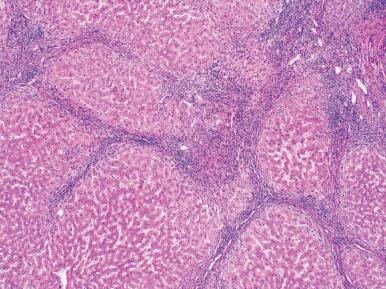
Several staging systems have been proposed for PBC. The most popular staging system, which is applicable to any vanishing bile duct disease, is that of Ludwig et al., which distinguishes four stages: portal (stage 1); periportal (stage 2); septal fibrosis (stage 3); and cirrhosis (stage 4). Staging of PBC in small needle biopsy specimens is valuable as long as it is interpreted with caution, bearing in mind that there is considerable variability in the degree of fibrosis in different parts of the liver. As mentioned previously, new staging systems have been proposed more recently, some of which aim to provide more correlation with clinical laboratory data, and some of which take inflammatory activity into consideration as well as fibrosis and other features of chronic cholestasis.
Liver cell dysplasia of the large and small cell type may be present, and the risk for development of hepatocellular carcinoma is also increased in PBC, particularly in patients with cirrhosis. Nodular regenerative hyperplasia has also been described in association with PBC ; together with narrowing of portal vein branches, this may explain the development of portal hypertension in some patients even before the development of fibrosis and cirrhosis.
The differential diagnosis of PBC requires consideration of two groups of diseases. Early-stage PBC must be distinguished from other diseases characterized by portal inflammation and bile duct damage, such as chronic hepatitis C, and later stage PBC must be differentiated from other chronic ductopenic diseases.
In the bile duct lesion in viral hepatitis C, the affected duct segment shows vacuolization and stratification of cholangiocytes, with less marked duct damage and preservation of the basement membrane. Cholestatic features are absent as well. Although focal lymphocytic cholangitis and mild bile duct damage is occasionally seen in autoimmune hepatitis, significant duct damage and copper deposition are not, and the degree of inflammatory activity is typically much less in PBC than autoimmune hepatitis. As mentioned previously, immunohistochemistry for IgM and IgG may also be helpful. Drug-induced bile duct damage is also in the differential diagnosis, and clinical history and a positive AMA may be invaluable in this circumstance. Other conditions characterized by bile duct damage and granulomas include sarcoidosis and granulomatous infections. The latter may cause real problems of differentiation, as it also may lead to ductopenia and chronic cholestatic liver disease (see later); the final diagnosis requires consideration of the clinical context and laboratory data.
Autoimmune cholangitis or autoimmune cholangiopathy is clinically, biochemically, and histologically very similar to PBC, but AMAs are negative, hence the alternative term AMA-negative PBC. Clinically and histologically there are no discernable differences, although the diagnostic threshold tends to be higher, and the treatment and prognosis mirror that of classic PBC.
PSC is a rare but important liver disease that leads to cirrhosis and the need for liver transplantation in a high proportion of cases. The disease occurs in approximately 1 per 100,000 people per year and usually presents in adulthood but does occur—albeit rarely—in children; men are affected more often than women. The natural history of PSC is variable, the average survival being 12–17 years. The cause remains unknown, although a number of genetic associations have been identified, many of which overlap with those found in other autoimmune diseases. Other hypotheses include ischemic injury (“arteriosclerosis of the bile duct”) initiated by toxic biliary lipids, and alterations in the gut microbial composition. Many patients (approximately 70%) with PSC suffer from inflammatory bowel disease as well, often a distinct phenotype that most resembles ulcerative colitis but has a higher incidence of pancolitis, backwash ileitis, and rectal sparing. It has also been hypothesized that aberrant expression of endothelial adhesion molecules, cytokines, and chemokines secondary to colitis may contribute to the development of PSC.
PSC is characterized by inflammation, strictures, and saccular dilations in the biliary system; any part of the biliary tree may be involved. The majority of PSC patients have involvement of both large and small ducts. “Small duct PSC” corresponds to involvement of only the microscopically identifiable (septal and interlobular) intrahepatic bile ducts, previously classified by the now obsolete term “pericholangitis.” A high prevalence of small duct PSC is found among patients with overlapping features of AIH and PSC. Cholangiography and microscopic examination of a liver biopsy are complementary investigations in PSC, with primary importance given to cholangiography.
The histopathologic changes in the liver biopsy of patients with PSC depend on the stage of the disease and on the site of the biopsy in relation to the duct lesions caused by the disease. In portal tracts proximal to strictures, only features of obstruction and cholangitis may be seen.
Portal tracts affected by the primary disease may show pleomorphic and fibro-obliterative cholangitis, the characteristic lesion of PSC, occasionally characterized by onion-skin type periductal fibrosis ( Fig. 19.49A and B ) with degeneration and atrophy of the epithelial lining. Chronic portal inflammation is variably present. This results in disappearance of the duct and its eventual replacement by a fibrous scar. Occasionally, however, biopsies show only duct atrophy with associated ductular reaction ( Fig. 19.50 ). Loss of ducts is more frequent in smaller portal tracts, whereas periductal fibrosis is more often seen in medium-sized tracts. Periductal fibrosis is not a pathognomonic lesion, as it can also be observed in other types of biliary disease, but it is a very suggestive and helpful finding. It is important to recognize, however, that it is not present in every stage of the disease or in all cases and is found in fewer than 40% of biopsy specimens. PAS–diastase staining may reveal thickening of the basement membrane around damaged ducts ( Fig. 19.51 ), or wrinkled empty basement membranes. In some patients, the scars of the vanished bile ducts are unusually prominent, resembling keloid scars. The parenchymal changes in PSC are less striking than the portal ones, and correspond to features of chronic cholestasis when present, including periportal copper deposition.
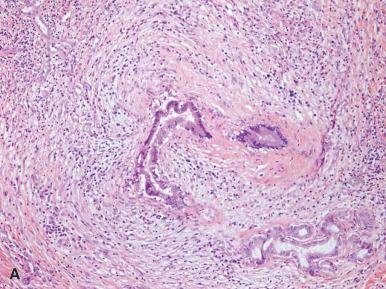
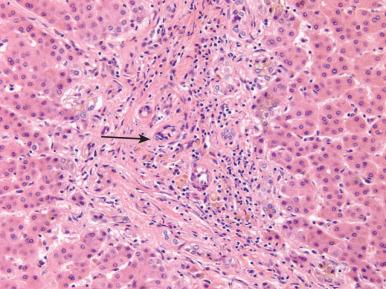
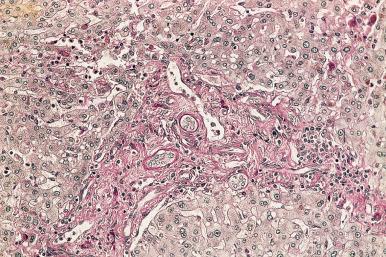
In patients with longstanding and more severe disease, portal fibrosis is more marked, fibrous septa develop, and biliary cirrhosis ensues. More progressive disease is characterized by moderate to severe lymphocytic interface hepatitis.
The most dreaded complication of PSC is cholangiocarcinoma. Patients with PSC and inflammatory bowel disease also have a high long-term risk of developing colorectal carcinoma, however, and this risk is about threefold higher than the risk for cholangiocarcinoma. A strong association has been found between dysplasia of bile duct epithelium and cholangiocarcinoma in PSC, suggesting that biliary dysplasia might be used as a marker for current or developing malignancy (see also Chapters 20 and 21 ). The results of a review of 100 consecutive formalin-fixed PSC liver explants (including 30 with cholangiocarcinoma) strongly supported a metaplasia–low-grade dysplasia–high-grade dysplasia–carcinoma sequence in PSC-associated cholangiocarcinoma, and underscored the lack of correlation between patient age, duration of PSC, and the development of cholangiocarcinoma. Dysplasia is generally confined to large and septal-size bile ducts, and its presence may not be recognized unless multiple sections of this caliber duct are examined.
The main differential diagnoses for PSC are chronic hepatitis and other ductopenic diseases, particularly PBC and IgG4-associated sclerosing cholangitis (see later). Chronic hepatitis lacks periductal fibrosis, ductopenia, and other cholestatic features; in addition, PBC may be difficult to differentiate from PSC in the later stages, but in earlier stages PBC typically features more prominent inflammation, florid duct lesions, and granulomas. Of note, however, epithelioid granulomas can also be found in about 4% of PSC cases but not as part of granulomatous cholangitis. Female gender and positive AMA also strongly favor PBC. An overlap syndrome between autoimmune hepatitis and PSC has been described (see later).
Although first described in 1961, autoimmune pancreatitis was not widely recognized as an autoimmune condition until 1995. It has now become apparent that this form of pancreatitis is part of a clinical syndrome that commonly affects multiple organs (see also Chapters 21 and 22 ). Many terms have been proposed to describe the condition, but “IgG4-related systemic sclerosing disease” appears most appropriate. Affected extrapancreatic tissues include the biliary tract, liver, kidneys, and lung, but a wide range of other sites may be involved.
Grossly, IgG4-SC may produce fleshy lesions along the biliary tree, and imaging studies may mimic either PSC or cholangiocarcinoma. One of the most common histopathologic features is the presence of numerous IgG4+ plasma cells within involved tissues, as well as lymphoplasmacytic infiltration of the duct with extensive storiform fibrosis, and obliterative phlebitis, similar to IgG4-associated sclerosing pancreatitis ( Fig. 19.52 ). Peribiliary glands are also severely affected. Bile duct epithelia are relatively spared in IgG4-SC in comparison with those of PSC. In some cases numerous IgG4+ plasma cells are also found in small portal tracts. The distinction from PSC may be very difficult, but the finding of more than 10 IgG4-positive plasma cells per high-power field and an IgG4/IgG ratio of more than 40% favor IgG4-SC, as does the presence of storiform fibrosis, elevation of serum IgG4, and involvement of other organs. However, these histologic changes are often lacking on needle biopsy. Although cases of PSC may show increased numbers of IgG4+ plasma cells, they are typically not as numerous as IgG4-SC, and IgG4-SC does not typically have “onion-skin” fibrosis or significant ductopenia affecting small ducts; however, we have seen rare cases of IgG4 disease with these features. Interestingly, hepatic inflammatory pseudotumor (HIP) has also been associated with IgG4-SC and is considered a local exaggeration of IgG4-SC. Therapeutically, IgG4-SC responds very well to steroid therapy, and thus the distinction from PSC has considerable clinical importance.
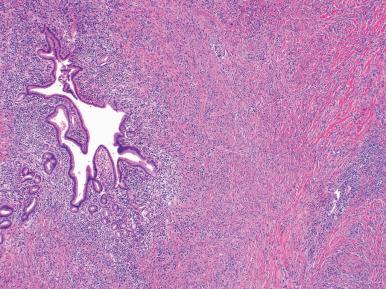
Become a Clinical Tree membership for Full access and enjoy Unlimited articles
If you are a member. Log in here